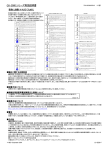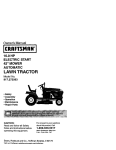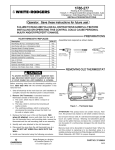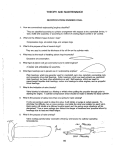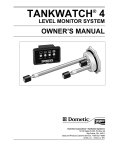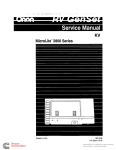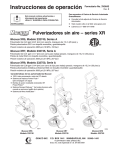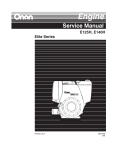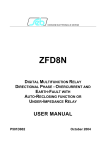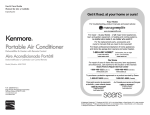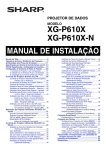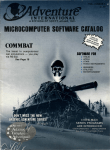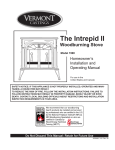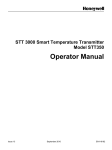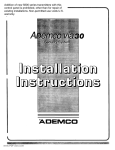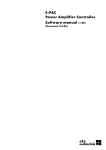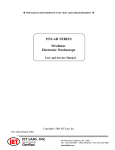Download 900-0192 Onan UV 300-750 KW Generators & Controls Service
Transcript
Caution: This document contains mixed page sizes (8.5 x 11 or 11 x 17), which may affect printing. Please adjust your printer settings according to the size of each page you wish to print. Service Manual 300 to 750 k W Generators And Controls Troubleshooting and Test Procedures For Generators Regulator Controls 9oo-0192 9-80 Printed in USA I 3 TABLE OF CONTENTS . TITLE PAGE Safety Precautions.................................................... 2 Introduction 3 Voltage/Current Options 4 .......................................................... .............................................. . . ........................................... 5 ................................................ 7 ................................................. 7 .............................. .......................... 17 SECTION II - CONTROLS .......................... .:...... .I. ......... 33 Relay Control Operation ............................................ 34 Relay Control Troubleshooting ...................................... 39 Solid State Control Operation........................................ 51 Solid State Control Troubleshooting ................................... 55 One Fault Lamp Control ............................... :........57 Six Fault Lamp Control ........................................... 57 SECTION I .GENERATORS Troubleshooting Generators with End Bell Mounted Voltage Regulators Troubleshooting Generators with Control Panel Mounted Voltage Regulator Procedures : . Wiring Diagram Index ................................................. ' . i 1 72 SAFETY PRECAUTIONS The following symbols in this. manual highlight conditions potentially dangerous to the operator, or equipment. Read this manual carefully. Know when these conditions can exist. Then, take necessary steps to protect personnel as well as equipment. . If adjustments are made while the unit is running, use 'extreme caution around hot manifolds, moving parts, etc. Do not work on this equipment when mentally or physically fatigued. This symbol warns of immediate k@!@@d hazards which wlll result in severe personal injury or death. GUARD AGAINST ELECTRIC SHOCK Disconnect electric power before removing protective shields or touching electrical equipment. Use rubber insulative mats placed on dry wood platforms over floors that are metal or concrete when around electrical equipment. Do not wear damp clothing (particularly wet shoes) or allow skin surfaces to be damp when handling electrical equipment. This symbol refers to a hazard or 1 severe - personal injury unsafe practice which can result in or death. This symbol refers to a hazard 'or unsafe practice which can result in personal injury or product or property damage. > , Disconnect batteries to prevent accidental engine start. Jewelry is a good conductor of electricity and should be removed before working on electrical equipment. PROTECT AGAINST MOVING PARTS Use extreme caution when working on electrical components. High voltages cause injury or death. Avoid moving parts of the unit. Loose jackets, shirts or sleeves should not be worn because of the danger of becoming caught in moving parts. Follow all state and local electrical codes. Have all electrical installations performed by a quaiified licensed electrician. Make sure all nuts and bolts are secure. Keep power shields and guards in position. ABBREVIATIONS To avoid repetitious use of terms or designations, abbreviations have been used as follows: R-S-R N.C.' Nor . >. VDC VAC L,op HET Kc Q. , R" i . I e O B O/C . LET , Run-Stop-Remote Normally closed Normally open Volts Direct Current Volts Alternating Current Cow Oil Pressure High Engine TempGrature Relay Transistor' Resistance/Rheostat, Capacitor Overspeed Overcran k Low Engine Temp Crystal Rectifier (diodes) Voltage Regulator Circuit Breaker Reactor Transformer l i m e Delay Light Emitting Diode Silicon Controlled Rectifier CR VR CB L T T.D. LED SCR , ' J 2 INTRODUCTION FOREWORD * . 1 This manual is divided into two sections as follows: 1. GENERATOR-Consists of general s p e c i f i c a t i o n s o n t h e UV generator, troubleshooting guides, and procedures for testing and repairing the systems. 2. CO NTR 0LS-T r o u b les h o o t i t i g g u ides , procedures for testing and repairing the system are contained in this section. A description of components and an analysis of module circuitry are included. This manual provides troubleshooting and repair information for ONAN series U V generators. It is intended to provide the maintenance technician, serviceman or Onan distributor with a logical procedure to enable him to systematically locate and repair malfunctions in the generator and control systems. This information is not applicable to the prime mover; refer to the engine manufacturer's manual. Repair information is not extensive because solidstate printed circuit modules lend themselves more to replacement than repair. ONAN does not recommend repair of the printed circuit module, except at the factory and has initiated a returdexchange service obtainable through distributors, whereby faulty modules can be returned and exchanged for good units. For more information, contact your distributor or the ONAN service department. TEST EQUIPMENT Most of the tests outlined in this manual can be performed with an AC-DC multimeter such as a Simpson 260 or 262 VOM. Exercise care when purchasing a foreign made VOM. Some units deliver +9VDC, others, +22VDC to the circuit under test on R x 1scale. Maximum recommended voltage is +l.SVDC. Damage to solid state devices can result from excessive voltage application. m Application of meters or high heat soldering irons to modules by other than qualified personnel can result in unnecessary and expensive damage. CAUTION . ' EZ3 The use of high potential test equipment (meggers) on generator windings can cause damage to solid state components. Isolate these components prior to testing. I GENERATING SET. MALFUNCTION I I ENGINE FAILSSEE ENGINE SERVICE MANUAL GENERATOR FAILS-SEE GENERATOR SECTION PAGES 5 THRU 32 CONTROL FAILSCONTROL SECTION .PAGES 33 THRU 71 3 - TABLE I.-VOLTAGE/CURRENT OPTIONS KILOWATTS/ c 625 DFZ 2255 I I 1187 1128 -1 2169 I .2050 I 1084 'Exhaust,gases-contain-carbonmonoxidei an odorless and colrrless-gas. Carbon monoxideis poisonous and cancause.unconsciousnessand death.3yyptoms 6f caibonmonoxidqpoisoning:can'include: 0 $Dizziness 4 Nausea ' 0 .Headache J Weakness and-Sleepiness 'a !Thrdbbing in$emples 'MuscularXwitohing .Vomiting 0 'Inability to=Think.Coherently ' IF YOU OR-ANYONE-ELSEEXPERIENCE ANY OF THESE SYMPTOMS, GETOUT INTO THE FRESMdIR IMMEDIATELY. If symptoms persist, seek medical attention. Shut down the unit and:do not operate until it has been inspected and repaired. 'Protection against carbon monoxide inhalation includes proper installation and regular, frequent visual and audible inspections of the complete exhaustsystem. 1-PlEM I 1025 SECTION I-GENERATQR GENERAL -+ The ONAN series UV generator is a revolving field, brushless, 4-wire 3-phase unit. Stator coils are brought out and connected to a bus-bar assembly to produce series wye, parallel wye or delta windings in the current/voltage options of Table 1. These options are factory connected to customer requirements. Loads are connected to the bus-bar assembly through a load transfer switch. Phase rotation is counter-clockwise (ACB). In early UV generators the voltage regulator was mounted on the generator end bell. More recent models have the voltage regulator mounted in the control cabinet. The three diodes and two SCR’s, that make up the regulator bridge, are now encapsulated in a hermetically sealed box. If a diode or SCR fails the entire box must be replaced, do not attempt to repair it. RECTIFIERS AINALTERNATOR ROTOR VR 1 VOLTAGE REGU LA7‘OR (COVER REMOVE c ,EXCITER L FIELD C O I L BEARING DOUBLE SEALED (INSULATED) STATOR WINDING -AUTOMATIC OVERSPEED S H U T D O W N COMMUTATING FIGURE 1. EARLY UV GENERATOR END VIEW (FRONT GRILLE REMOVED) 5 BRUSHLESS GENERATOR AND REGULATOR The moment of gate energizing shifts t o an earlier point when the voltage sensing circuit detects a drop in voltage output. Firing earlier causes the exciter t o produce greater output and thus increase generator output. All the UV series generators are brushless exciter controlled. Alternating current from onestator output winding is fed through a normally closed field breaker to a regulator bridgeon thevoltage regulatorchassis. The generator output increases because the exciter field causes a rise in the exciter armature output which is converted to DC by the rotating diode network (mounted on the exciter armature) and supplied to the generator: rotor field. A rise in generator output then causes the voltage sensing circuit in the regulator to fire SCR’s for a shorter period in the AC wave and reduce exciter output to a normal level. The full wave bridge is composed of two silicon controlled rectifiers (SCRs) and three rectifierdiodes. This SCR bridge delivers rectified current from the voltage sensing circuit to the generator’s exciter field in timed pulses, determined by an increase in gate voltage, to change positive and negative (PN) junctions from Reverse to forward bias. This change lets current flow until the half cycle reaches zero voltage. 6 b- ’GENERATOR TROUBLESHOOTING DOES GENERATOR HAVE END BELL MOUNTED VOLTAGE REGULATOR? If “yes” follow guides A thru D; i f “no”. follow guides E thru 1. TROUBLESHOOTING GUIDES A. CONDITION: NO GENERATOR OUTPUT ENGINE RUNNING RATED RPM - page 9 B. CONDITION: GENERATOR OUTPUT TOO HIGH OR TOO LOW ENGINE RUNNING STEADY RPM - page 11 C. CONDITION: GENERATOR VOLTAGE BUILDS UP, CIRCUIT BREAKER TRIPS. ENGINE RUNNING STEADY RATED RPM - page 12 D. CONDITION: UNSTABLE OUTPUT. ENGINE RPM NOT FLUCTUATING - page 12 DOES GENERATOR HAVE CONTROL PANEL MOUNTED VOLTAGE REGULATOR? If “yes” follow guides E thru I; if “no”follow guides A thru D. TROUBLESHOOTING GUIDES E. CONDITION: NO AC OUTPUT VOLTAGE ENGINE RUNNING RATED RPM - page 13 F. CONDITION: UNSTABLE OUTPUT-ENGINE RUNNING AT 1800 RPM WITH NO FLUCTUATION - page 15 G. CONDITION: OUTPUT VOLTAGE TOO HIGH OR LOW H. CONDITION: EXCITER CIRCUIT BREAKER TRIPS I. - page 15 - page 16 CONDITION: UNBALANCED GENERATOR OUTPUT VOLTAGE 7 - page 16 PREPARATIONA few simple checks could expose the probable source of trouble or at least cut down on troubleshooting time. Check all modifications, repairs, replacements performed since last satisfactory operation of set. A loose wire connection, overlooked when installing a replacement part could cause problems. An incorrect connection, an opened circuit breaker, a relay not secure are all potential malfunction areas to be eliminated by a visual check. Unless absolutely sure that panel instruments are accurate, use portable test meters for troubleshooting. Visually inspect components on printed circuit boards. Burned resistors, arcing tracks are all identifiable. Do not mark on printed circuit board with a pencil. Graphite lines are conductive and can cause short circuits between components. c The question and answer troubleshooting guides which follow, give a step-by-step procedure for checking t h e generator. To use this guide, answer the question either “yes? or “no” then proceed to the step given in the column containing .your answer. When a ietter appears inlhe. Method column, refer to that letter in the Procedure section for the recommended method for testing or repairing. a .. QUESTION AND ANSWER TROUBLESHOOTING GUlDE To correct a problem, answer the question “Yes” or “No,” then proceed t o the next step given in whichever column the question was answered. ITEM 2 2 Is panel circuit breaker (CBl) in the ON position? 4 3 Switch CB1 to ON. Does generator output build up? a. Is output high or low? (See Guide B) b. Does CB 1 trip? (See Guide C) c. Is output unstable? (See Guide D) ~ NO ~ METHOD I I Is panel meter selection switch positioned correctly for a voltage/current reading? 1 . YES 4. CONDITION: NO GENERATOR OUTPUT ENGINE RUNNING RATED RPM ~ Shut down engine. Apply temporary jumper across TB1-66 and TB1-65 inside control cabinet. Restart engine. Does voltage build up? Remove jumper. Shut down engine. Check wiring between TBl-65, TBI-66 and CB1. If wiring is good, replace CBl. Check wiring between voltage regulator (VRl) and control panel terminal board. Refer to applicable wiring diagram. 7 Check wiring between VR1 and bus-bar assembly. 8 8 Restart engine. Measure VAC across VR1 terminals 4 and 5 (residual voltage). Does voltmeter read 20 to 24 VAC? 10 9 10 . With engine running, place CBI to OFF. Using method described under A in procedure section, flash exciter field to restore residual magnetism. Place CB1 to ON. Does the AC voltage build up? A - 10 15 11 Shut down engine. Check continuity of fuse F1 on VR1 circuit board. Is continuity obtained? 12 - Check silicon controlled rectifiers CR1 and CR2. Are SCRs CRI and CR2 OK? 13 - Measure VDC across V R l terminals 2 and 3 (positive lead on 3) with engine running. Does voltmeter read 10 to 90 VDC? 1 ~ 11 12 _ _ ~ ~ 9 ~ B TEM A. CONDITION: NO GENERATOR OUTPUT ENGINE RUNNING RATED RPM (Continued) YES NO METHOD Check diodes CR3 and CR4. Are diodes CR3 and CR4 OK? 14 - C Check L1 commutating reactor for continuity. Is L l good? 15 D Disconnect exciter stator leads F1 and F2 at VR1 terminals. 2 and 3. Measure continuity between F1 and F2. Is continuity obtained? I6 E 16 Are rotating diodes CRI thru CR6 on exciter rotor OK? 17 C 17' Replace Voltage regulator VR1. Resta'it engine. Does getierafor vbltage build up3 13 14 NOTE: Reactor L1 is connected across VR1-1 and 5. See Figure 1 for location. 15 . 18 - . IS excifet' . . . . . . ~ . J .. rotor winding' OK? ........... 19' Are. ge'ner'ator stator windings OK?.. 20 Are gerierdtoi roWr windiri$s&? . . . ~ ..... .. F L . .. . . . . . . . , - G . . . . . . i, _..... . . . . . . . . . . . . . . . . . . .- . . . . 10 . ._. . . . . H' ITEM 1 B. CONDITION: GENERATOR OUTPUT TOO HIGH OR TOO LOW-ENGINE RUNNING STEADY RPM Rotate voltmeter/ammeter phase selector switch. Is discrepancy identifiable on all switch positions? I I YES I NO 4 1 2 I 2 Can condition be corrected by adjustment of voltage control rheostat R1 on panel? 3 If output is too low, is unit overloaded? 9 5 4 Connect portable voltmeter across panel voltmeter terminals, rotate selector switch. Do portable meter and panel meter readings agree? 5 8 c 5 METHOD r Measure VAC across VR1-6 and 8. Does voltmeter read I20VAC? 6 7 - 6 Replace voltage regulator VR1. - 7 Replace voltage reference transformer in control cabinet. - 8 Replace voltmeter. 9 If all phases overloaded, remove non-essential loads until low voltage condition is corrected. I f overloaded on one or two phases, rearrange single phase loads until phases are balanced. ~ Single phase load capacity is W3 that of total rated 3 phase capacity of unit, Le., total 3 phase capacity 450 kW, 1 phase capacity 300 kW. 11 J ~~ ITEM 1 C. CONDITION: GENERATOR VOLTAGE BUILDS UP, CIRCUIT BREAKER TRIPS-ENGINE RUNNING STEADYRATEDRPM YES Does generator voltage build up excessively before circuit breaker CB1 trips? 2 Are all wires and connections at voltage regulator V R l in good condition? 3 3 Are diodes CR19, CR1 thru CR4 on VR1 good? 6 4 Check rotating diodes CR1 ,thruGR6. Are diodes good? 2 . ~ 5 Replace circuit breaker CBI. 6 Replace voltage regulator V R I . ITEM i METHOD .5 ~~~ .- I ... .. .D. :CONDITION: 'UNSTABLE:O.UTPUT.'. . PB3 in control cabinet. 1 Check conngctions at VRl; .Was repair required? 2 Can condition be corrected by adjustment of damping potentiometer R19.on V R l ? 3 Replace voltage .regulator V.Rl. .... .' L ',YES '. I I- 12 i METHOD : ' I ITEM E. CONDITION: NO AC OUTPUT VOLTAGE ENGINE RUNNING RATED RPM 1. 2. I - YES Isthe Exciter Circuit Breaker (CB21) on the meter panel in the “ON” position? 3 Switch CB21 to the “ON” position. Does the AC voltage build up? ~ 3. 4. 5. 7 9. 2 - - Is the AC voltage measured at terminals 1 and 2 on voltage regulator (VR21) printed circuit board 5 to 10 volts? 4 - Is the AC voltage measured at terminals 11 and 12 on VR21 5 to 10 volts? 5 7 Replace reactor assembly (L21). ~ ~- Is the DC voltage measured at terminals + and - on Rectifier Bridge (CR21) 5 to 10 volts? 15 Shut down generator set. Check continuity between terminal 2 on VR21 and T8 on generator, between terminal 1 on VR21 and T7 on generator. Is there continuity between these connections? VR21-2 to T8 VR21-1 to T7 14 14 ~ 8. METHOD 3 ~~ ~~~ 6. NO - NOTE: If voltage builds up but is high, low or unstable, or causes CB21 to trip, refer to section G or H of the troubleshooting guide. . I I ~ If no continuity exists between VR21-1 and T7 (CB21-ON) apply a shorting jumper across CB21. Is continuity obtained? - ~~ 9 Replace circuit breaker CB21. 10. Check for loose or broken wires on VR21, CR21, reference voltage transformer (T21), generator bus-bars and terminal board (TB21) in control box. Secure or repair where necessary. If repairs have been made, restart engine. Does AC voltage now build up? 11. Are diodes CR1, CR2 and CR3 on CR21 assembly good? (See method 0 in procedure section for checking diodes.) If faulty diode located, replace CR21. 12 0 12. Are SCRs 4 and 5 in CR21 good?, (See method 0 in procedure section for checking diodes.) If faulty SCR’s located, replace CR21. 13 0 13 E ’ - I E. CONDITION: NO AC OUTPUT VOLTAGE ENGINE RUNNING RATED RPM (Continued) YES I I I NO 13. Fault probably lies with a defective component on VR21. Replace voltage regulator VR21. - 14. Start engine. Place CB21 in “OFF” position. Using method prescribed under “M” in procedure section flash the exciter field to restore residual magnetism. Place CB21 ON. Does the AC output voltage build up? 15 I METHOD M 15. Shut off engine. Is the exciter field winding OK? 16 E 16. Are the rotating diodes CRl through CR6 on the exciter rotor OK? 17 C 17. Is the main generator field winding OK? 18 H 18. Is the exciter rotor winding OK? 19 - F 18. Are the generator stator windings OK? 13 - G . .. ., I . . .. . , ? . . , I . , ., ’.. -. 14 . F. CONDITION: UNSTABLE OUTPUT-ENGINE RUNNING AT YES 1800 RPM WITH NO FLUCTUATION Are there any loose or broken wires or connections at voltage regulator VR21 terminals? Does adjustment of R26 (damping control potentiometer) on VR21 stabilize generator voltage? II- NO METHOD 2 1 - Replace VR21 voltage regulator. I ‘ I I I ITEM I G. CONDITION: OUTPUT VOLTAGE TOO HIGH OR LOW I I I YES I Does adjustment of R21 “voltage adjust knob” on the meter panel correct voltage level? I- Does adjustment of R18 potentiometer on VR21 correct voltage level? Are rotating diode heat sink mounting screw insulators OK? 1 5 Replace voltage regulator VR21. - I METHOD I 31 4 Are the reconnections correct and secure? 15 NO -I L I ITEM I H. CONDITION: EXCITER CIRCUIT BREAKER TRIPS 1. I Does AC output build up to 150% or more of rated voltage before CB21 trips? YES I NO I METHOD I NO I METHOD 2 Are there loose or broken terminals or connections at voltage regulator VR21? 2' 3. Is CR21 rectifier assembly OK? 4. Are the reference voltage transformer (T21) windings and connections OK? 5. Replace voltage regulator VR21. 6. Does AC output build up to rated value before tripping CB21? 7. Are the rotating diodes CRI through CR6 on the exciter rotor OK? - Is the exciter stator winding OK? I 9. I Is the generator main field winding OK? 10 Is the exciter rotor winding OK? 10. L YES 1. CONDITION: UNBALANCED GENERATOR OUTPUT VOLTAGE - Remove load from generator terminals. Is output still unbalanced? 1 2 Are generator leads properly connected or grounded? 3 Is generator stator winding continuous? 4 4. Is grounding procedure of generator and load correct? 5 5. Check for ground faults on load. - 16 +' 4 Remove frontal griile to gain access to voltage regulator. Disconnect lead F1 at VRI-3. Start unit. Touch positive lead of supply to F1 and negative to VRI-2. Hold leads on terminals just long enough for vohage to start building up. Shut down unit and reconnect wires. 'FLASHING THE FIELD * - I f output voltage does not build up, it may be necessary to restore residual magnetism of the poles by flashing the field. Assemble a six-volt dry cell (lantern) battery and diode as shown in Figure 3. If a lantern battery is not available, a 12 volt automotive (generator set) battery can be used by installing a 20 ohm, 2 watt resistor in series with diode; or a 24 volt automotive (generator set) battery can be used by ;Increasing resistor value to 40 ohms. a If generator output builds up, high voltage will be present on voltage regulator terminals. Use caution in vicinity of high voltage equipment, otherwise personal injury or death may result. WARNING Do not keep field flashing circuitryconnected longer than 5-seconds or damage may occur to exciter and regulator. FI REMOVED FROM TERMINAL 3 e &/ 12 AMP 300 PIV DIODE F2 TERMINAL 2 ........ ........ ........ .................. .................. ............. ......... . FIGURE 3. FIELD FLASHING CIRCUIT 17 TESTING SCRs To check silicon controlled rectifiers (gated diodes), proceed as follows: Alternate method If an ohmmeter is not available, or if output voltage of ohmmeter is excessive, assemble test circuitry as in Figure 4D, using a6voltdrycell andacurrent-limiting bulb. 1. Remove voltage regulator V R I cover to gain access to SCRs. 2. SCRs on V R l are identified CR1 and CR2, and are positioned closest to the terminal board. See Figure 15. Perform test per items 4 and 5; bulb should not light. With leads connected as in Figure 4D, apply jumper from anode to gate, bulb should light, and remain ON when jumper is removed. It is important to know correct polarity of theohmmeter leads. Red and black, or + and - on the meter are not necessarilyan indicationof the battery output polarity of themeter on OHMS range. Results different from those given above indicate a bad SCR. Replace 3. Remove gate and cathode wires from SCR. 4. With ohmmeter set on R x 10K scale, measure resistance across anode and cathode. Meter should read 1 megohm or greater (Figure 4A). 5. Reverse leads as shown in Figure 4B. Reading should again be 1 megohm or greater. 6. With leads connected as in step 5 (meteron R x 1 scale), short gate to anodeasshown in Figure4C. The resistance should drop to 25 ohms or less. 7. Remove the short between gate and anode; the resistance should .remain unchanged. 8 . Results n,ot in accord with those given above indicate a bad S'CR. Replace. D I 'ANODE 0 A OHMMETER OHMMETER SH'ORT BET.WEEP~ GATE, A N D ANODE . i' .. .. rGATE ANODE "--"LEAD . ANODE FIGURE 4. I TESTING SCRs (GATED DIODES) 18 "+"LEAD . REPLACING SCRs and CRs 1. Unsolder leadwires from terminals. 2. Use proper size wrenches to hold the body while removing the nut. 3. Push the rectifier free of its mounting hoie in the heat sink. 4. Insert new rectifier into its mounting hole in the heat sink. Using nut and washer provided, secure rectifier to heat sink. 5. Torque diodes on rotating exciter assembly to 15 Ib. in. (1.7 Nmm). TESTING DIODES Six diodes labeled CR1 thru CR6 are mounted on the' rotating exciter assembly as shown in Figures 2 and 5 .labeled CR3 and CR4, on V R l . Test diodes as follows: 1. Remove one diode at a time from heat sink. Test that diode and reinstall on heat sink before proceeding to the next one. 2. Check the resistance of the diode with an ohmmeter. Connect one lead to the top of the diode and other lead to the diode stud. Observe reading. See Figure 6. 3. Now reverse leads and again observe reading. A good diode should have a higher reading in one direction than the other. If both readings are high, or if both readings are low, diode is defective and must be replaced with a new, identical part. 6. Solder leadwires to new rectifiers. Use a 40 watt soldering iron. Hold a needlenose pliers between rectifier and soldering point to prevent destructive heating. Excessiveheat on these components will destroy them. , 1CR3 A N D C R 4 - Excessive dust or.dirt on diodes and other components will cause overheating and eventual failure. Keep these assemblies clean! VR I 'CRl - CR6 R O T A T I N G RECTIFIER FIGURE 5. ROTATING RECTIFIER ASSEMBLY , LEAD LEAD GOOD D I O D E W I L L H A V E H I G H RESISTANCE READING I N O N E D I R E C T I O N AND L O W READING W H E N OHMMETER L E A D S ARE REVERSED. FIGURE 6. TESTING DIODES 19 rD1 'CHECKING REACTORS To measure resistance of the L1 commutating reactor (315-0301) use a Wheatstone bridge; use a Simpson 260 ohmmeter for measuring coil resistance on L2 reactor (315-0300), and insulation resistanceon both L1 and L2. L1 and L2 are mounted on voltage regulator VR1. Resistance measurement of L1 is taken' across coil termirials, see Figure 7. Reading should be 0.0693 to 0.0847-ohms at 20" C (68OF). Sefohmm'eter'scale to R x IOK, measure between either coil terminal' and frame. A reading less than infinity indicates low insulation resistance in the coil winding. Replace reactor. , Resistance.measurement.of C2:is.taken across.coil' terminals 1 and 4.; see Figure 8. Reading should' be, 308':8 to 977.4 ohms at' 20°C (6'8"F), meter on-R'x 1 scale. With meter'on:R:x IOK seale;:a reading..ofless. than infinity between any coil terminal arid:.frame indicates. low. insulation' resistarlce, replace reactor. . .. Measure con'tinuity between eithertermiildl Tor4 and termitials-.2and.3'to..veiifytapS.arxi not.-broken:. .. gzi MEASURE MEASURE 8306 FIGURE '7. L1 (315-0301) FIGURE 8. 20 L2 (315-0300) , [El CF1 ~~ EXCITER ROTOR - The resistance of the exciter rotor is extremely small. Accurate measurement with an ohmmeter is not possible, however an open winding can be detected with an ohmmeter. To check the rotorwindingsforan open remove rotating diodes CRI, CR2, CR3, Figure IO, from the heat sinks. Measure rotor winding resistance as shown in Figure 11. The ohmmeter should indicate a short. TESTING EXCITER STATOR Testing for grounds: Using an ohmmeter (R x 10K scale), measure the insulation resistance between either lead F1 or F2 and the generator frame. A reading of less than infinity indicates a ground. Exciter stator leads F1 and F2 are connected across voltage regulator V R l terminals 2 and 3. . . CR2 rftr CR3 Testing winding resistance: Measure coil resistance between leads F1 and F2 with an ohmmeter (scale R x 1). Resistance should be 14.85 to 18.15 ohms at 20°C (68°F). See Figure 9. FIGURE 10. ROTATING DIODE ASSEMBLY Test f romCRI toCR2 CR1 to CR3 CR4 to CR5 CR4 to CR6 Replace rotating diodes on heat sinks. Hold body of diode with proper size wrench while torquing, to prevent wire from twisting. Torque to 15 Ib-in. (1.7 Nom). Using an ohmmeter on R x 10K scale, measure between any rotating diode lead and generator frame. A reading of less than infinity indicates low insulation resistance of the exciter windings. FIGURE 9. MEASURING FIELD RESISTANCE . . . .. . .. . .. . .. . . .. .. . . . ..: ... . .. . . . . . . .' .. .:. . . . I . . .. . . .. . . . 21 , .. . . . . [GI TESTING GENERATOR STATOR TESTING GENERATOR ROTOR Testing for Grounds: Disconnect stator leads from Testing for grounds: Remove F+ and F- rotor leads from diode heat sin'k assemblies. Connect an ohmmeter (R x 10K scale) between either rotor lead and the rotor shaft. A reading of less than infinity indicates a ground. See Figure 13. bus bar assembly; observe wire identification. Connect all stator output leads (TI-T12) together. Use an ohmmeter set on the R x 10K scale and measure the insulation resistance between thesewindings and the stator frame. A reading of less than infinity indicates a ground. See Figure 12. . C O N T A C T O N E PROD T O E A C H O F T H E FIELD LEADS . A N D T H E OTHER P R O D T O T H E ROTOR SHAFT. FIGURE 13. .TESTING ROTOR FOR GROUNDS FIGURE 12. TESTING STATOR WINDINGS Testing for Shorts: Connect an ohmmeter (R x 10K scale) between each individual winding and the other windings connected together. Repeat until all Six Coils have been tested. A readingpf less than infin'ity indicates a short. See Figure 12A. Accurate measurement of the generator rotor windings resistance with an ohmmeter is impossible, however an open winding can bedetected. On agood generator rotor the ohmmeter. would indicate a rq,i?ance Of lessthan five Ohms* Accurate measurement of the generator statorwindings resistance with an ohmmeter is impossible, however an open winding can be detscted. The ohmmeter normally would indicate a short. - .. ... -. . .. .-'a; 1- . , . FIGURE 12A. STATOR COILS (SCHEMATIC) 22 FIGURE 14.. MEASJ~INGROTOR WINDING RESISTANCE [JI VOLTAGE REGULATOR Voltage adjustment of generators with voltage regulators VRl mounted on the end bell is accomplished by turning Voltage Regulator rheostat on control panel. If voltage is unstable or tends to hunt adjust R18 potentiometer on the regulator board to eliminate output instability. Refer to Figures 15 and 16. FIGURE 15. VOLTAGE REGULATOR PRINTED CIRCUIT BOARD (TYPICAL) VOLTS I m '1' T O EXCITER FIELD i= *d ! VOLTAGE ADJUSTING RHEOSTAT 12ov - ON CONTROL PANEL Ln VOLT REF FIGURE 16. VOLTAGE REGULATOR SCHEMATIC (TYPICAL) rKl ’GENERATOR ASSEMBLY Pre-assembly Procedure ‘GENERATOR DISASS EMBLY (300-500 kW) 1. Inspect bearing; replace if necessary. Torque bearing locknut 150 to 200 Ib f t (203to 271 Nom). 2. Inspect bearing rubber holding ring. Replace if If testing determines that generator needs repair, disassemble and remove according to Figure 17 and the following instructions: 1. Disconnect batteries. 2. Disconnect and remove load wires. 3. Disconnect lead wires from control box. Check wire markings for legibility to ease assembly. Reidentify if necessary. Arrange leads so that they can be withdrawn easily from control box. 4. Disconnect engine control wires and voltage regulator wires and pull back into cabinet. 5. Remove ten 3/8 inch bolts (1) and lift control cabinet assembly (2)clear of set. 6. Remove two 3/8 inch bolts (3)and cooling fan grille (4). 7. Remove six 3/8 inch bolts (5)and remove upper and lower sheet metal covers (6). 8. Remove. four 10-32 screws (7) and voltage regulator. 9. Support generator on wooden blocks placed across skid base. IO. Remove two 5/8 bolts (8),two 5/8 studs (9),four 3/4 inch bolts (10) from generator support bracket. Remove shims from between support bracket and skid base; identify shims with placement reference; save for reinstallation. Remove generator support bracket (11). 11. Remove six 3/8inch bolts (12)and endbell (13). 12. Attach overhead hoist and sling to stator assembly. Tension hoist sufficiently to take weight of stator. Remove support blocks. 13. Remove sixteen 1/2 inch bolts securing stator, and slide stator assembly clear of rotor. Ez3 necessary. Apply Molykote to ring before installing. 3. Inspect all mounting bolts. Replace any bolts that. show’signs of being stretched. ASSEMBLY 1. Hang rotor in place; rotate40 align; insert six 5/8 inch bolts with lock washers. Torque bolts 120to 125 Ib ft (162to 1.70Nom). 2. Using hoist and sling, slide stator assembly in . , place. Ezz3 Use care to ensure that damagedoesnot occur to rotor or stator windings while stator is being positioned; , CAUrlo~ Align stator, insert sixteen 1/2 inch bolts and lockwashers. Pull up bolts evenly, then torque 65 t o 70 Ib f t (88t o 95 Nom). 3. Install end bell assembly. Ensure rubber holding ring is not distorted while end bell is being positioned on rotor bearing. Rock gently into place and pull up evenly with six 3/8 inch bolts and washers. Torque bolts 30 to 35 Ib ft (40to 48 Nom). 4. Atta,ch generator support bracket; insert two 5/8 inch bolts with washers. Torque bolts 195 to 200 Ib ft (264to 272 Nom). 5. Insert two 5/8 inch studs with nuts and lockwashers. Torque 195 to 200 Ib ft (264 to 272 Nom). 6. Install shims in same position from which they were removed. 7. Insert support bracket-to-skid base bolts and tighten. 8. Reinstall voltage regulator, upper and lower sheet metal covers, cooling fan grille, and control cabinet assemblies. 9. Refer to parts catalog for replaceable parts and assemblies. Refer to wiring diagrams for reconnection. Exercise care when sliding stator over rotor. Collision with coils can cause damage. 14. Attach sling and hoist to rotor. Tension hoist to take weight of rotor. 15. Remove six 5/8 inch bolts and slide rotor. clear from flywheel. 16. Lower rotor and place on a support cradle where coils cannot receive damage. # c. ._I , When removing drive diskfromflywheel, do not bend disk. 24 1 (IO PLACES) 9 -aJSTATOR ASSY. END B E L L I 3 FAN DRIVE DISC .. SUPPORT 3 FIGURE 17. GENERATOR DISASSEMBLY 25 . I generator support bracket (11). 11. Install wedges between rotor and stator, Figure 18. 12. Remove six 3/8 inch bolts (12) and endbell (13). 13. Install rotor support rod to free end of rotor, Figure 19. 14. Support the free end of the rotor support rod. 15. Attach overhead hoist and sling to stator assembly. Tension hoist sufficiently to take weight of stator. Remove support blocks. 16. Remove wedges from between the rotor and stator. 17. Remove sixteen 1/2 inch bolts securing stator, and slide stator assembly clear of rotor, keeping the rotor supported at end of rotor shaft. 18. Install support under rotor whenstator is clear of rotor, Figure 20. GENERATOR DISASSEMBLY (600 & 750 kW Only) If testing determines that generator needs repair, disassemble and remove accordingto Figure 17 thru 20 and the following instructions: 1. Disconnect batteries. 2. Disconnect and remov,e load wires. 3. Disconnect lead wires.from control box. Check wire markings for legibility to ease assembly. Reidentify if necessary. Arrange leads so that they can be withdrawn easily from control box. 4. Disconnect engine control wires and voltage regulator wires and pull back into cabinet. 5. Remove two 3/8 inch bolts (3) and lift control cabinet assembly - (2) . . clear of set. 6. Remove six 3/8 inch bolts (3) and cooling fan grille (4). Exercise ,care when sliding stator over .,.. 7. Remove six 3/8 inch bolts (3) and remove upper rotor. CQliision with coils can cause and lower sheet metal covers (6). damase. 8. Remove four screws (7) and "'Itage .19. Attach sling and hoist to rotor. Tension hoist to regulator. take weight of rator. 9. Support generator on wooden blacks placed 20. Remove rotor support rod. across skid base. 21. Unbolt the drive disk from engine. 10. Remove two 5/8 bolts (8), two 5/8 studs (9); four. . When removing drive disk from engine, 3/4 inch bolts (10) from generator support do not bend disk. bracket. Remove shims from between s u ~ ~ o r t 22.. Lower rotor and place on a support cradle where bracket and skid base; identify shims with place- . coils cannot be damaged. . ment -reference; save for reinstallation. Remove ' ! ' FIGURE 18. WEDGE INSTALLATION ' 26 FREE END O F ROTOR .I/ I I ROTOR SYPPORT ROD I !t-n--wpI---- - -+ \ -I "AID - ROTOR , I I SUPPORT FROM FLOOR STATOR FIGURE 19. STATOR REMOVAL I I DISC I !, 0" 48' ENGINE -- --- -+SKID --- I\-ROTOR SUPPORT FIGURE 20. ROTOR REMOVAL GENERATOR ASSEMBLY Pre-assembly Procedure 1. Inspect bearing; replace if necessary. Torque bearing locknut 150to 200 Ib-ft (203 to 271 Nom). 2. Inspect bearing rubber holding ring. Replace if necessary. Apply Molykote to ring before installing. 3. Inspect all mounting bolts. Replace any bolts that show signs of being stretched. 27 5. Align stator, insert sixteen 1/2 inch bolts and lockwashers. Pull up bolts evenly, then torque 65 to 70 Ib ft (88 to 95 Nom). 6. Place wedges between the rotor and stator. See Figure 18. Then remove the rotor support rod from the rotor. 7. Install end bell assembly. Ensure rubber holding ring is not distorted while end bell is being positioned on rotor bearing. Rock gently into place and pull up evenly with six 3/8 inch bolts and washers. Torque 6 bolts 30-35 lbft (41to 48 Nom): 8. Attach generator support bracket; insert two 5/8 inch bolts with washers. Torque bolts 195 to 200 Ib ft (264 to 271 Nam). 9. Insert two 5/8 inch studs with nuts and lock washers. Torque 195to 2001bft (264to 271 Nom). 10. .In.stall shims 'in. same position .from which they were .removed; . 11. I-nsert. support bracket-to-skid base -bolts arid ASSEMBLY 1. Support rotor and attach drive disk toengine. See Figure 20.Torque bolts 120to 2001bft (163to271 Nom). When installing drive disk to engine, do not bend disk. 2. Install support under rotor. 3. Install rotor support rod to free end of rotor, supporting the free end of the rotor support rod. See Figure 19. 4. Using hoist and sling, slide stator in place. See Figure 21. Exercise care when sliding stator over rotor. Collision with mils tan cause damage. ROTOR SUPPORT ROD . tighten. . . . 12. Re4nsW .voltage regulator, upper and. lower ' R. ROTOR . .STATC)R: . .FIGURE 21. STATOh'fNS?ALL:A%lON . . Sheet.metalcovers, coaling fangrille, and conlroi c86iriet'assemblies. : 13. Refer to parts catalog for replaceable parts and assemblies. Refer. .to wiring diagrams for .reconnection. . . : '14. Rtpnn'ect lead w.ires to coritrol box. 15. hstall and: 'recoritfeot.laad .wires, 16. .Reconne6t...batteries. ' -' 28 . . L21 REACTOR \ / CR2l SCR BRIDGE 8199 FIGURE 22. SCR BRIDGE AND REACTOR LOCATION c5 CR3 I CR15 1 I I 'B F3 ~ 1 4 R13 . I I. 2 3 4 5 7 6 VR21 BOARD 8 9 I011 A!33-PC FIGURE 23. VOLTAGE REGULATOR VR-21 29 12 TBI I VOLTAGE ADJUSTMENT After replacement, voltage regulator (VR21) adjustment is performed as follows (see Figure 24): 1. Center the voltage adjust knob so pointer is in a vertical position. 2. Open meter panel doors. Start unit. 3. Using a screwdriver, turn R18 potentiometer on printed circuit board VR21. Observe voltmeter on meter panel while making adjustment. Set voltage with no load connected to generator. (Example: For a 120/240 volt connection, set no-load voltage to. approximately 246 volts.) RECTIFIER BRIDGE FIGURE 25. FIELD FLASHING CIRCUIT If voltage is unstable or tends to hunt, turn R26 potentiometer on VR21 in the direction shown on printed circuit board to increase voltage dampening (Le., decrease sensitivity). TESTING L21 REACTOR The L21 commutating reactor mounts inside the control box, below the VR21 Voltage Regulator. i ADJUST R26 HERE The coils 1-2 and 3-4 are wound on the same.core. Resistance between 1-2 and 3-4 should be equal. Resistance between coils (e.g., 1-4) or from any terminal to frame of the reactor should be infinity (Figure 26). \ ADJUST R18 HERE FIGURE 24. ADJUSTING VOLTAGE ON VR21 FLASHING THE FIELD If output voltage does not build up it may be necessary to restore the residual magnetism of the poles by flashing the field. Assemble a sixvolt battery and diode as shown in Figure 25. If a six volt lantern battery is not available, a 12 volt (generator set battery) or a 24 volt battery can be used; however, a 20 ohm or 40 ohm, 2 watt resistor must be used with the 12 amp, 300 volt diode. Start the generator set, touch positive lead to +on rectifierbridge, and negative lead to the - terminal. Hold leads on terminals just long enough for voltage to build up. jl[ I rn Do not keep excitation circuitry connected longer than 5-seconds, or damage may occur to !he exciter regulator. cAutlo.N FIGURE 26. L21 REACTOR 30 4 TESTING RECTIFIER BRIDGE ASSEMBLY (CR21) The rectifier bridge located within thecontrol cabinet, below the voltage regulator, contains 3 diodes, CRI, CR2, and CR3, and two silicon -controlled rectifiers, CR4 and CR5. These diodes and SCRs are encapsulated within an hermetically sealed box, therefore failure of any diode or SCR means the entire unit has to be replaced. See Figure 27. < Ti CR4 A2 AC TERMINALS ARE GIVEN NUMERIC DESIGNATIONS FOR T E X T REFERENCE ONLY. DOES NOT APPEAR ON UNIT. 'G2 AC-2 1D FIGURE 27. RECTIFIER ASSEMBLY Disconnect wires from rectifier unit prior to testing. Test unit in order shown in Table 2. Refer to Figure 28 for CR4 and CR5 test circuit. When test is complete and satisfactory, reconnect unit observing correct wiring hook-up. ' 7--- 6 VOLT DRY C E L L BATTERY D C VOLTMETER FIGURE 28. TESTING SCR 31 TABLE 2. TESTING SCR ASSEMBLY CR21 TEST OHMMETER LEAD + - RECTIFIER TERMINALS X - + X 1 X 2 x i ,I : - + TES CR - REMARKS METER SCALE CR3 Infinity RXlOK 6 to50.Ohms R X I DC Voltmeter 4ead DC Voltmeter Reading CR3 - 3 - . . . . .i,CRl .?I . ., X ,5 : - :;j( . . . .! _ . l. x 16 '!; 3 - .. ' .ACJ - +-- AG2 ................ ... 7 !,. GRd .............. , i - ;x .: 3 : .... - :AC2 - CR2 ~ - x 8 .. J .CR2 AC2 6 V Battery with 100R Resistor + + - AC1 9* lo** AC2 + AC2 r'* Apply temporary jumper from AC1 to G1 to test CR4. Remove jumper, 8 read voltmeter. See Figure 28. ** Apply temporary jumper from AC2 to G2 to test CR4. Remove jumper, read voltmeter. See Figure 28. 32 - I + + less than 'I 3 Volts 3 Volts GENERAL Early UV series generator sets used relays exclusively, for engine controls. As the state-of-the-art has improved, O N A N has been able to change concepts to improve quality and reliability of its product. Refer to Table 3. Locate the specification letter of a particular unit, the tablewill tell you which pageof the controls section of this manual is applicable to your generator set. TABLe 3. CONTROLS LOCATION Page 52 1 and 5 Light Solid State Control Begin Spec DFT DFU WF WK DFV DFW DFY DWV DFX DFZ . B C A A D A C, D only * D only * B only * B E B A A Page 54 6 Light Solid State Control Begin Spec H k B A A DFT spec E. DFU spec E. and WF spec C controls information located in theYB series majorservice manual, ONAN No. 900-0181, and Generator Section 9. of Master Service Manual, 922-0500. 33 K14. FUEL RELAY (One and four lamp systems) The following operational description is applicable only to relay-operated engine controls. See Figures 29 and 30. Same type of relay as K13. K11. OIL PRESSURE TIME-DELAY RELAY (One and four fault lamp systems) Energized when R-S-R switch is placed in Run position. N.O. contacts 6-8 close to apply 24VDC to battery charging alternator for field excitation. Energized after engine has started, by output from AUX terminal of battery charging alternator. Relay contacts close 15 seconds after 24VDC is applied to coil. This delay allows engine to startand oil pressure t o build-up while the Low Oil Pressure switch is still closed. When K11 relay actuates, N.O. contacts close and complete circuit between K15 and. LOPCO switch. N.O. contacts 1-3 close to apply 24VDC to the following: a. . b. c. d. e. K12. CRANKING LIMITER TIME-DELAY RELAY (One and four fault lamp controls) Energized when R k - R switch is placed in Run Oil pressure gauge (M11) Water temperature’gauge (M13) K2 fuel solenoid valve K1 starter solenoid (thru K13 N.C. contacts) K12 cranking limiter relay (thru K13 N.C. contacts) after K13 relay has actuated-N.O. contacts close- f. K11 time delay relay; oil pressure g. K3 water solenoid valve position and K14 actuates. Relay energizes at initial current application and contacts OPEN 45 to 90 seconds later. This delay limits the period of time the engine starter will crank. If the engine does not start within this time period, N.O. contacts will open and allow K14 relay to drop out. On fourlight installations N.C. contacts will close and light the PLANT FAILED TO START fault light. If the engine starts, N.C. contacts K13, 1-4 will open and remove 24VDC from K12 coil, thus preventing any further time-out action. K15. EMERGENCY SHUTDOWN RELAY (Single light control only) In addition, on four lampsystemsonly, two extra N.O. contacts close when relay actuates. One set lights “Plant Failed to.Start” lamp, the other applies 24VDC to an external alarm circuit. Normally a de-energized relay, operates only with Low Oil Pressure, High Water Temperature, or Overspeed malfunction. LOPCO and HETCO circuits are “armed” when K11 operates. Closure of either of these two cut off switches applies a ground (through K11 contacts) to the coil of K15, causing it to energize with the following result: Cranking limiter is not used when a cycle cranker is installed at a remote station. ” a. N.C. contacts open to de-energize K14forengine shutdown and de-energize K15 coil. b. N.O. contacts close to light DS12 fault lamp. c. N.O. contacts close to apply 24VDC to common alarm circuit. K13. ‘START DISCONNECT RELAY (One and four fault lamp controls) Two pole, double throw relay, standard octal base plug-in. In the de-energized position N.C. contacts 14 connect t o K1 starter solenoid and K12 cranking limiter. The relay is energized when output from the battery charging alternator reaches coil pull-in value. N.C. contacts 1-4 open and remove 24VDC from K1 and K12, preventing further operation. N.O. contacts 1-3 close and apply24VDCto K11 which energizes, to arm the LOPCO circuit. Contacts 1-3 hold 24VDC on the water solenoid for engine cooling. If the relay has been energized, it is reset by manually pressing the latch button. Overspeed switch is a centrifugal unit which closes at 2000 to 2200 rpm and applies a ground to K15 to perform the functions previously described. Overspeed shutdown is not “armed” by K11 relay, therefore is not affected by its operation. 34 s12 - I 1 - DSll I7 I PANEL LIGHT , FIGURE 29. SCHEMATIC, SINGLE LIGHT 35 b b. N.O. contacts close to light DS15, Overspeed fault lamp. c. N.O. contacts close to apply 24VDC to alarm. K15. LOW OIL PRESSURE SHUTDOWN (Four fault lamp controls) With a four fault light panel, K15 relay has only one function, Low oil Pressure shutdown and fault lamp indication. Armed by K11 as previously noted, closure of LOPswitch (Sl)will applyagroundtoK15coiland cause it to actuate, with the following switching Fction: The preceding operational description refers to R-S-R switch in Run position. This is for purposes of brevity only. Identical functions will result with R-S-R switch in Remote, when remote station circuits are complete. a. N.C. contacts open, K14 drops out to shutdown engine, K15 coil is de-energized. b. N.O. contacts close to light DS13 LOP fault lamp. c. N.O. contacts close to apply 24VDC to alarm. OPTIONAL RELAYS K12. ALARM RELAY (Specs 9560A; 6925A; 5504A) The following relays are used with four fault lamp control panels. See Figure 30. Energized .by signal from remote station, which also lights “Failed to Start”fault lamp. N.O. contactsclose, apply 24VDC to TB11-12 for external alarm. K16. HIGH WATER TEMPERATURE‘ SHUTDOWN (HETCO) K18. REMOTE START RELAY (Spec 9560A) . Placing R-S-R switch to Run applies 24VDC to K16 coil. The relay is then in a ready condition and when the high water temp switch S2 closes at approximately 216°F (102OC) aground is applied to theotherside of K16 coil. TIME-DELAY Used only with remote start. The three-second delay between energize and actuate prevents unit-engine start when a sudden drop in utility company voltage indicates a power-out, unless thevoltagedip exceeds 3-seconds. The relay will actuate and perform the following switching action: Actuation of the relay closed N.O. contacts to complete circuit between TB12-Remote and R-S-Rswitch in Remote position. a. N.C. contacts open, K14 drops out to shut down engine. b. N.O. contacts close to light DS14 High Water Tem peratu re Fault light. c. N.O. contacts close to apply 24VDC to alarm. ENGINE CONTROL OPERATION, Spec 9730A r ’ , 1 L This system has engine shutdown for Overcrank and Overspeed only, all other malfunctions operate alarms. Operation of K12 Cranking Limiter, K13 Start Disconnect, K14 Fuel Relay and K15 Overspeed Shutdown are as previously described. K17. OVERSPEED SHUTDOWN Placing R-S-R switch to Run applies 24VDC to K17 coil. Relay is then in a ready condition. An engine Overspeed condition i n excess of 2000 rpm will cause a centrifugal switch mounted on the generator shaft, to close and complete the relay ground circuit. The following relaysK16 Low Oil Pressure alarm, K17 High Water Temperature alarm, K18 Low Engine Temperature alarm, K19 High oil Temperature alarm, -are double pole, single throw units. Each has one set of N.O. contacts which close to apply 24VDC to TB13, then to a remote annunciator panel. See Figure 31 for schematic diagram. The relay will actuate and perform the following switching action:,: a. N.C. contacts open, K14 drops out to shut down engine. 36 W K1 K13 r\ rk K12 K I3 4 6 1 1 HI 11 " 1 CBI I I .ipJ-@i I , - I . . 17 DS12 J'i K15 I I DS15 12 - T O ALARMS .7 K17 FIGURE 30. SCHEMATIC, FOUR LIGHT 37 TYPE 3 CYCLE CRANKER 625-0821 (Specs power is removed from the engine starter circuit, and from K2, which de-actuates -10-seconds later and allows K1 to dropout. K2 will again pull in, K1 will energize and then actuate, and the crank/rest time will continue until K3 actuates, N.O. contacts close K4 to pull-in,open N.C. contacts and shut and circuit. down the engine ' 550419; 6925A; 9560A) This optional unit combines cranking limit time and a number of crank/rest cycles within this time. Referring to Figure 31 it will be seen that relays K1, K2and K3 are adjustable time-delay units. K1 and K3 delay between energize and actuate, K2 delays between deenergize and de-actuate. Placing R-S-R switch in Run position applies24VDC through cycle relay 'Ontact' K4 and K1 to control panel relay K14 which pulls-hand starts the engine cranking cycle. This same24VDC is applied to cycle cranker 7elay K3 which controlthe cranking limiter time period. Relay K2 actuates and doses Contacts to apply 24VDC to K1. When K1 actuates, ' If the engine starts within the K3 energize/actuate time limitroutput from the battery charging alternator will actuate relay K13 which will switch and apply 24VDC to cycle cranking relay K5. This relay will pull in and keep the cranking circuit de-energized. Relay K4 is a mechanical-latch type..In the event of non-start, K4 will drop out and disable the cranking circuit, which will remain disabled until K4 Is manually reset by depressing the latch button. 6309 FIGURE 31. TYPE 111 CYCLE CRANKER (625-0821) 38 RELAY CONTROL TROUBLESHOOTING Is this a single fault lamp control? If “yes” see guides A thru C, I and J. If “no” see guides D thru TROUBLESHOOTING GUlDES A. CONDITION: Engine will not crank. R-S-R switch in run position - page 41 B. CONDITION: Engine will not crank R-S-R switch in remote position - page 43 C. CONDITION: Engine will not crank R-S-R switch in remote position - page 44 1. CONDITION: Engine running Starter re-engages - page 49 J. CONDITION: Engine will not start, but continues to crank in excess of 90-seconds cranking limiter time - page 50 Isthisafourfault lamp control? 1f“yes”seeguides Dthru H, I and J;if“no”seeguidesAthruC, I and J. TROUBLESHOOTING GUIDES D. CONDITION: Engine will not crank R-S-R switch in run position - page 45 E. CONDITION: Engine malfunction shutdown Plant failed to start - page 46 F. CONDITION: Engine malfunction shutdown Low oil pressure page 47 - G. CONDITION: Engine malfunction shutdown High water temperature - page 47 H. CONDITION: Engine malfunction shutdown Overspeed condition page 48 - 1. CONDITION: Engine running Starter re-engages - page 49 J. CONDITION: Engine will not start but continues to crank in excess of 90-seconds limiter time - page 50 -cranking _*. . . . H. GENERAL Before you start the troubleshooting procedure, visually inspect all wiring and connections. Check relay plug-in receptacles for cold solder joints. Look at the engine control and wiring. Check that no broken or shooed wires and no loose terminals exist. This troubleshooting guide assumes that your knowledge of the electric generating set will allow you to consider the nature of the fault before proceeding. Forexample, your set cranks without starting; you will check fuel, fuel lines, ignition,carburetion, etc. If it does not crankCheck Batteries Connected properly? Connections secure? Fully charged? Starter Connections secure? ‘Remote Station start switch in correct position? A few minutes spent logically analyzing a malf,unction can save hours and expense on an inoperative generating set. This manual will help you with your electrical control problems. Consult your engine operator’s manual .for engine troubleshooting infor.mation. To use-this guide, answer the question either‘!yes” or “no” then .proceed -to the step given in the column containing your answer. 40 QUESTION AND ANSWER TROUBLESHOOTING GUIDE To correct a problem, answer the question "Yes" or"No", then proceed to the next step given in whichever column the question was answered. Preparation for troubleshooting. Check batteries for state of charge. Check wiring and connections for correct connection and security. DFT, DFU. DFV. DFW. Specs R8/1A; R8/50A, R8/8554A, R8/9730A. WF. WK. R8/1A. Single Fault Lamp Control CONDITION: A. ENGINE WILL NOT CRANK R-S-R SWITCH IN RUN POSITION Item Is Fault lamp lit? 1 2 3 I Yes 2 Reset relay K15 latch button. a. Does fault lamp go OFF. Does engine crank? b. Does fault lamp stay ON? c. Does fault lamp QO OFF, then ON? Replace K15 relay. ~ ~ No 4 ~ ~ R-S-R Run 3 5 _ _ ~ I- Reset relay K12. Does engine crank? 5 stop Unplug K14 relay. Measure resistance from TB11-11 to ground. Is resistance reading Infinity? 6 - Disconnect wire to Overspeed switch. Measure resistance of lead to ground. Is resistance reading Infinity? 8 7 -- Replace or readjust Overspeed switch 8 9 Measure resistance from TI31 1-1 1 (O/S switch still disconnected) to ground. Is resistance reading Infinity? 10 Replace K 1 1 , Oil Pressure Cut-off relay. 10 Reconnect wires disconnected at TB11-3 1. Plug-in K14 relay. 11 Measure voltage at starter.* Does coil wire read 24 VDC (solenoid terminal wired to B+) Does motor input read 24 VDC (cable from solenoid terminal t o terminal on top of starter) Run 'DFX and DFZ units have two starters wired in series. 12 Replace starter. 13 Measure voltage at TBll-6. Does voltmeter read 24 VDC? 14 Measure voltage at starter circuit breaker where wire connects from relay K1. Does voltmeter read 24 VDC? 41 I l4 15 17 18 - Item I A. ENGINE WILL NOT CRANK (Continued) Place temporary jumper across circuit breaker terminals. Does engine crank? I Replace circuit breaker. I I Check wiring and connections between battery and terminal board. Repair, replace, secure where necessary. l7 18 Measure voltage at TB11-5. Does voltmeter read 24 VDC? I Yes I 16 17 - - Run 23 Measure voltage .at coil input ,terminal on starter solenoid .K1.. Does voltmeter read 24 V.DC? 20 : 22 Measure .resistance from ,Klcoil .return co.nnec,tion to ground. .Is continuity obtained? 21 22 21 Replace starter solenoid K1. - - 22 Check all wiring and connections to KI. Replace, repair, secure as necessary. - - 23 4Joplug relay ,K13. Measure voltage at receptacle pin 1. Does voltmeter read 24 VDC? Reinsert K13 relay.. 20 24 ' 24 26 25 25 Replace K13 Relay. - - 26 Toggle R-S-R switch between Run and Stop positions; watch relay K14 during this operation. Does K14 relay actuate? - 27 Unplug relay K14. Measure voltage at receptacle pin 7. Does voltmeter read 24 VDC? Reinstall Relay K14. stop Run' 31 . Recheck latching of K12 and' K15 relays. Check wiring and connections (refer to schematic). Replace, repair, secure where necessary. Was repair required? stop 32 30 Check wiring and connections between K14-7 and TB12-Ground. Repair, replace, secure where necessary. - 31 Replace relay K14. - 42 28 -. Measure continuity between K14 and pin 2 and ground. Is continuity obtained? 29 ' - 28 Stop 'Run Check wiring and connections between K13-4 and TBll-5. Replace, repair, secure as necessary. Was repair required? 27 stop 1-119 19 R-S-R NO Item 32 33 1 A. ENGINE WILL NOT CRANK (Continued) I Measure voltage at R-S-R switch. Does voltmeter read 24 VDC? Check wiring and connections at R-S-R switch. Repair, replace, secure where necessary. Was repairrequired? - stop - 34 Replace R-S-R switch. Itern 1 2 3 Switch R-S-R switch to Run position. Does engine crank? Return R-S-R switch to Remote. Apply temporary jumper across TB12-B+ and Remote terminals. Does engine crank? Apply temporary jumper across Start switch at remote station. Does engine crank? 2 AI 3 5 4 6 . 4 Replace remote station start switch. 5 Check wiring between TB12-Remote and R-S-R 'switch. Repair, replace, secure where necessary. - 6 Measure continuity between TB12 and Remote station. Repair, replace, secure where necessary. - - 43 t f -I - -E, CONDITION: c. ENGINE Itern - MALFUNCTION SHUTDOWN Yes . No - Did engine shut down immediately after start (i.e., within 3 seconds)? 5 2, 2 Did engine shut down 10 to 20 seconds after start? 6 3 Did engine shut down 45 to 90 seconds after start? 14 1 - 4 Did engine shut down after running, crank for 45 to 90 seconds, then shut down without cranking? Fqult light ON after cranking cycle complete? WF and WK sets only. 5 Check throttle Jinkage for freedom of movement. Check governor setting. Check overspeed switch. Readjust or replace as necessary. 6 Check engine crankcase .oil. Does oil need replenishing? 7 Disconnect switch y i r e at TB-11-14. Restart engine. Watch oil pressure gauge. Does Engine run satisfactorily? Does oil pressure build up to normal? 8 Refer to engine manufacturer’s manuaJ for oil system troubleshooting guides. 9 Disconnect oil pressure switch. Measure resistance between wire and ground, Ohmmeter scale R x 10K. Is reading less than infinity? -. 14 l.6 30 10 Repair or replace wire. 11 Connect ohmmeler (R x 1 scale) between oil pressure switch and ground. Start engine, observing ohmmeter. Does ohmmeter reading go to infinity when engine starts? 12 Replace oil pressure switch. 13 Shut down .engine. Visually check oil pressure time-delay relay contacts. Manually operate armature and make sure contacts make and break properly. If contacts hang up or are stuck, replace relay. 14 15 Check fuel. Are tanks (day tank and main fuel tanks) full? Check fu.el system; lines, pump, etc. 16 Check fuel lines; gas pressure, etc: 17 ‘Check ignition system. Refer to engine manufacturer’s ,manual for troubleshooting . . fueland ignition . . systems. . ; 44 15 11 Preparation for troubleshooting. Check batteries for state of charge. Check wiring and connections for correct connection and security. Four Fault Lamp Control R-S-R SWITCH IN RUN POSITION ~ ~~~~ ~ Yes - ~ Is one of the following fault lamps ON? a. Generator Set Failed to Start? Refer to guideb. Low oil pressure? Refer to guidec. High Water Temperature? Refer to guided. Overspeed? Refer to guide- E F G H Toggle R-S-R switch between Stop and Run; watch K14 relay. Does K14 operate? No 2 - - - 8 3 5 4 Refer to Figure 26, Schematic Diagram. Progressively measure continuity from R-S-R switch through K12, K17, K16, K15, to K14-7. Repair, replace or secure wiring or connections where necessary. - - Measure continuity between K14-2 and TI312 Ground. Is continuity obtained? 6 7 Replace K14 Relay. - - Check wiring and connections between K14-2 and TB12 Ground. Replace, repair, secure where necessary. Reinsert relay. - - Toggle R-S-R switch betweenstop andRun; hold K1 Starter solenoid. Does K1 operate? 13 9 ~ ~ ~~ I-S-R Run ~~ Unplug K14 relay. Measure continuity between K14-7 and R-S-R switch armature. Is continuity obtained? stop -- Measure voltage at TB11-5. Does voltmeter read 24VDC? Run 10 18 Measure voltage at coil terminal of K1. Does voltmeter read 24VDC? 11 - Measure continuity fromyround side of K1 coil terminal to ground. Is continuity obtained? 12 - Replace K1 Starter solenoid. - - ~ ~ ~~ stop ~~ Measure voltage at starter motor relay coil terminal. Does voltmeter read 2.4 VDC? ~ Run 16 14 15 - ~~ Apply temporary jumper across circuit breaker CB1. Does starter crank? 45 Item 15 D. ENGINE WILL NOT CRANK R-S-R SWITCH IN RUN POSITION (Continued) Replace starter circuit breaker. 16 Are starter to battery cable connections secure? 17 Replace starter motor. 18 Unplug relay K13. Measure continuity across relay pins 1 and 4. Is continuity obtained? 19 Replace relayK13. 20 Check wiring and connections between TBll and K13 and K14 relays. Repair, replace, secure where necessary. 2 t Yes No Reset latch button on relay K12. Does engine crank? Does engine start? - c2 2 Refer to engine manufacturer’s manual for engine non-start troubleshooting guides. - - Item 1 R-S-R stop 46 Four Fault Lamp Control LOW OIL PRESSURE SHUTDOWN Itern 1 Yes No - 2 Does oil pressure build up to normal, then engine shut down? Does engine shut down before pressure build up? 3 7 - Disconnect lead from low oil pressure switch (Sl). Measure continuity between lead and ground. Is continuity obtained? 4 5 4 Repair or replace lead. - - 5 Connect ohmmeter between S1 and ground. Reset relay K15. Restart engine; watch ohmmeter. Does switch open when oil pressure builds up? - 6 Replace oil pressure switch. - - Yes NO Check engine crankcase oil quantity. Is oil required? Reset latch button on K15 oil pressure relay. Start engine; watch oil pressure gauge. 2 3 6 Refer to engine manufacturer's manual for low oil Four Fault Lamp Control ~ONDITION: G. ENGINE MALFUNCTION SHUTDOWN HIGH WATER TEMPERATURE SHUTDOWN Itern Check coolant. 1 Avoid removing the pressure cap on the radiator until unit has cooled. If this is impractical, the system may be opened while hot i f certain precautions are taken. While wearing rubber insulated gloves for protection, slowly open the cap allowing the pressure to vent. This is necessary to avoid personal injury from contact with hot coolant or steam. ~ 2 Check fan belts. 3 Check coolant pump drive belts. 4 Check radiator (if appropriate) and remove any obstructions to air flow. Reset latch button on relay K16. Restart engine. If city water cooled system, adjust water flow to keep engine within normal operating temperatures. ~~ Check load on generator. Reduce load if excessive. 47 , ' Preparation for troubleshooting. Loss of governor control or ingestion of contaminated air will cause an engine to overspeed. This can be caused by either a faulty governor, uncoupled, sticky or binding throttle linkage to the governor; or intake air containing fuel or oil vapor. When an engine has shut down because of an Overspeed condition, check the following before continuing with the troubleshooting guide. a. Throttle linkage for freedom of movement b. Both banks of cylinders are connected to governor throttle linkage. Four Fault Lamp Corirrd c CONDITION: H. ENGINE MALFUNCTIOW SHUTDOWrJ . Item. 1 Yes Disconnect Overspeed switch lead from TB11-11. Measure continuity between disconnected lead and ground. Is continuity obtained? 2 Leaving ohmmeter connected, disconnect lead from Overspeed switch on generator shaft. Is continuity still maintained? 3 3 Repair or replace wire between TBl1-11 and Overspeed switch. - 4 Adjust or replace Overspeed switch. - 2 48 Single or Four Fault Lamp Controls ~ I CONDITION: c I. ENGINE RUNNING. STARTER RE-ENGAGES. Yes No Unplug K13 Start-disconnect relay. Measure continuity from AUX terminal on battery charging alternator to pin 7 of relay receptacle. Is continuity obtained? 2 5 Measure continuity from relay receptacle pin 2 to TB1 l-Ground. Is continuity obtained? 3 5 4 5 6 5 Remove cover from battery charging alternator voltage regulator. Measure continuity from relay K14 receptacle, pin 6 to input of battery charging alternator voltage regulator (ye1Iow w ire). Is continuitv obtained? Measure continuity from K13 receptacle pin 4 to coil input terminal of starter relay K1. Is continuity obtained? 3-S-R Check all wiring and connections in the previously mentioned circuits. Repair, replace, secure where necessary. Replug K13 relay. Do not close panel door. Restart engine; remove K13 relay as soon as engine Proceed with care! High voltages are present within the control cabinet, which could cause shock or serious personal injury. Measure voltage at AUX terminal of battery charging alternator. Does voltmeter read 24 VDC? Replace K13 relay with new unit. Measure voltage at excitation input terminal of battery charging alternator (yellow wire). Does voltmeter read 24 VDC? Replace battery charging alternator. 49 Run CONDITION: J. ENGINE WILL NOT START, BUT CONTINUES TO CRANK IN EXCESS OF 90-SECONDS CRANKING LIMITER TIME Item Yes 1 Disconnect one wire from resistor R11 (cranking limiter). Measure resistance from resistor tap to disconnected terminal. Is resistance approximately 7.5 ohms? 3 I No 2 2 If resistor indicates either open (infinity) or shorted, replace resistor. 3 Measure voltage at coil input terminal of K12 relay. Does voltmeter read 24'VDC? (after 90 seconds) 4 - Replace K12 relay. - - . 4 - 3 . 50 . R-S-R Run -. GENERAL Y This section of the manual is intended to instruct the serviceman on the operation of the relays and printed circuit modules which comprise the UV control system. Used in conjunction with the schematic diagrams at the back of the manual this information should provide the serviceman with greater understanding of the function of the system. TABLE 4. FAULT LAMP OPTIONS ~ SYSTEM PENN STATE SINGLE LIGHT STANDARD SINGLE LIGHT 5 LIGHT 5 LIGHT PR E-ALAR M PENN STATE FIVE LIGHT 6 LIGHT FAULT ~ ~~ FAULT LAMP STOP ENGINE X X X I Overcrank Overspeed Low Oil Pressure High Engine Temperature X X' X Overcrank Overspeed Low Oil Pressure High Engine Temperature X Overcrank Overspeed Low Oil Pressure High Engine Temperature Low Engine Temperature X X X X X X X X Overcrank Overspeed Low Oil Pressure High Engine Temperature Low Engine Temperature X X X X X Overcrank Overspeed Low Oil Pressure High Engine Temperature Low Engine Temperature X X X X Overc rank Overspeed Overvoltage Low Oil Pressure High Engine Temperature Low Engine Temperature X X X X X X X X X X X X * - 51 X SINGLE LIGHT. PENNSYLVANIA STATE STANDARD, SINGLE LIGHT SYSTEM A single fault lamp is standard equipment on early U V generator sets. The lamp will indicate a fault for any engine malfunction. Refer to the appropriate troubleshooting guide for single lamp fault location. Overspeed When the overspeed switch closes it completes a circuit to ground permitting the engine monitor to energize the fault lamp and relay K1, in turn deenergizing run relay K12,removing power from the Low Oil Pressure and High Engine Temperature circuits, and completing the circuit for the external alarm. ENGINE MONITOR MODULE A l l Overspeed The overspeed switch will close between 2000 and 2200 rpm, completing a circuit to ground that will allow the shutdown relay All-K1 to energize and shutdown the engine by interrupting the circuit that maintains relay K12 energized. The shutdown relay energizes the external alarm circuit and deenergizes . the low oil pressure, high engine temperature, and overspeed circuits. Overcrank Operation is the same as the standard single light system. . Overcrank High Engine Temperature and Low Oil Pressure When the R-S-R switch is placed to RUN the engine starts to crank and the overcrank circuit is energized. The maximum crank time (nominal 75 seconds) is determined by the charge rate of a capacitor in the overcrank circuit. The charge rate is adjusted by a rheostat (screwdriver adjustment). If the engine starts within 75 seconds, voltage supplied by the battery charging alternator will energize relay K11 and the overcrank capacitor will be discharged to prevent shutting down the engine. If the enginedoes not start, then K11 remains deenergized. The overcrank capacitor remains charged causing the engine monitor to energize shutdown relay K1. resulting in the same sequence of events described in the overspeed shutdown. There is no engine shutdown or fault lamp indication for these conditions. When the appropriate switch closes, relay K2 is energized which then closes contacts energizing the external alarm circuit. High Engine Temperature and tow Oil Pressure If either of these conditions occur the appropriate switch will complete a circuit to ground which will allow shutdown relay All-K1 to .energize after a nominal 12.5 second time delay. When the shutdown relay is energized the engine is shutdown in thesame manner as described for an overspeed condition. Reset: Relay K1 will remain energized as long as 24VDC is available to it. To reset K1 place R-S-R to STOP, then to. the desired operating position. 52 Y FIVE LIGHT ENGINE CONTROLS Overspeed Available on early UV sets the five fault light installation performs the functions asdesignated in Table 4. Refer to the appropriate troubleshooting guide for fault location. A centrifugal switch on the generator end bell closes between 2000 and 2200 rpm completing a circuit to ground enabling the engine monitor circuits to light the fault lamp and energize relay K1. Thecontacts of K1 initiatean engine shutdown as previouslydescribed. High Engine Temperature This fault indication system operates in two steps. A pre-alarm and a shutdown. Low Engine Temperature The Low Engine Temperature fault lamp is lit at any time the engine temperature is below a nominal 65" F (18.3" C). After engine start, the light will remain ON until engine temperature reaches 80" F to 90" F (26.7" C to 32.2" C). There is no alarm or shutdown with this indication. Pre-Alarm: When engine temperature reaches 200" F to 210" F (93.3"C to 98.9" C) the HET pre-alarm switch will close completing a circuit to ground which will allow engine monitor circuitry to energize the fault lamp and A11-K2. Contacts of K2 arm relay K1 (shutdown relay) and energize the external alarm circuit. c At a nominal 85" F (29.4" C) the LETswitch will open and the fault light will go out. Shutdown: High engine temperature switch closes when engine temperature reaches 210°F t o 220°F (98.9"C to 104"C), completing a circuit to ground enabling the engine monitor to energize K1. The contactsof'K1 in turn deenergize K12 to shutdown the engine. Lamp Test Push type switch mounted on engine monitor board, protruding through panel face, applies 24VDC and ground to fault lamps for test. This switch does not check out the module, and should be depressed ONLY WHEN ENGINE IS RUNNING. Low Oil Pressure Pre-alarm switch closes at 18 psi to 22 psi (124 to 152 kPa) completing a circuit to ground which lights the fault lamp and energizes relay K2. The contacts of K2 arm K1 (shutdown relay) and energize the external alarm circuitry. There isashort, (nominal 12.5 second), time delay before the fault lamp and relay K2 energize, to allow oil pressure to build up when first starting the engine. Run-Stop/Reset-Remote Switch Sing le-pole, doub le-th row, center-off toggle switch. In Run Position: applies 24VDC through A11-18 to engine monitor board. Stop/Reset Position: stops engine and allows relay(s) on engine monitor board to drop out. Remote Position: allow engine to be started from a remote station. Closure of, the remote station switch applies 24VDC to A1 1-18 through R-S-R switch. The LOP cut-off switch closes at 12 to 16 psi (83 to 110 kPa), completing a circuit to ground permitting the engine monitor to energize K1, causing the engine to shutdown. FIVE LIGHT SYSTEM. PENNSYLVANIA STATE Normally the LOP pre-alarm switch would be closed prior to starting the engine. Relay .K11 is energized only when the engine is running so its N.O. contacts in series with K2 prevent K2 from energizing and inhibiting engine starting. Essentially the same as the standard five light system previously described, but with the following exceptions: 1. No pre-alarm switches. 2. High engine temperature, alarm and light only. No engine shutdown. 3. Low Oil Pressure, alarm and light only. No engine shutdown. 4. Low Engine Temperature, light only. 5. Engine shutdown on Overcrank or Overspeed only. Use standard five light troubleshooting guides. Overcrank The operation oftheovercrankcircuits in thefivelight control is similar to the single light control system. . . Should the engine shutdown through loss of fuel, relay K11 will drop out, the engine will go through the 70 to 80 second crank cycle, then shutdown with an Overcrank indication.Therefore, the first things to check with an Overcrankshutdownareloss of fuel or, if applicable, ignition failure. 53 SIX LIGHT ENGINE CONTROLS Overvoltage The six light installation is standard equipment on UV series generator sets listed in Table 2. Light emitting diodes on the engine control modules light for each fault condition. These diodes should be used as a diagnostic device during troubleshooting, because the control panel lamps can burn out. Refer to the appropriate troubleshooting guide for fault location. The six light control uses integrated circuits as well as discrete solid state components. Even though the hardware is different than the five light control the basic operation of the LET fau,lt lamp and LED is the same in the six light system as the five light system. There is no external alarm or shutdown with this indication. The engine will be shutdown on a generator overvoltage condition. An auxiliary stepdown transformer is the sensing device for the overvoltage circuit. The primary winding of the auxiliary transformer receives its power from the output of the generator, therefore the secondary winding output voltage will be directly proportional to generator output voltage. When generator output voltage exceeds about 115% of the rated voltage the overvoltage shutdown circuit will provide the signal necessary to gate the SCR that provides a path to ground energizing relay A l l - K l . The shutdown is both time and magnitude dependent, that is the more severe the overvoltage condition the more rapidly the engine will be shutdown. At 110 to 120% overvoltage the time delay is infinite, but at 200% shutdown will occur within 2 seconds f 1 second. High Engine Temperature Reset Switch The operation of the HET pre-alarm and shutdown is basically the same as the five light control although the hardware used i n the circuits is different. The reset switch on the front of the control panel will reset the fault lamps on the control panel. When depressed it also provides a circuit to test the fault lamps. Low Engine Temp erat ure Low Oil Pressure Run-Stop/Reset-Remote Switch The basic operation of the LOP pre-alarm and shutdown is essentially the same as the five light system, except that it is performed with integrated circuits as well as discrete solid state devices. Double-pole, double-throw toggle switch. Switch is maintained in all positions (Pennsylvania state is spring return from STOP). Run Position: applies 24VDC to generatorset control. The Start Disconnect module prevents the Engine Monitor from shutting down the engine on LOP during the starting sequence. Once the engine is running there is a 10-15, (nominal 12.5), second time delay in the LOP shutdown circuit to allow the oil pressure to build up to the normal pressure. Stop/Reset Position: stops engine and allows shutdown and alarm relays, A l l - K 1 and K2, to drop out. Remote Position: Allows engine t o be started from a remote station. Overcrank This circuit allows a maximum engine crank time of 70-80 (nominal 75) seconds, regardless of the mode of operation of the Cycle Cranker module. If the engine does not start within 75 seconds the Engine Monitor overcrank circuit will provide a path to ground for relay A l l - K 1 (shutdown relay). When energized A1 l - K 1 N.C. contacts open, deenergizing K-12 (ignition relay) shutting down the engine. Shutdown Pre-Alarm Selector Switch Pre-alarm Position: the engine control system operates as previously described. All Pennsylvania state models use this position. Shutdown Position: the engine will shutdown when the pre-alarm switch for either HET or LOP operates. There is no pre-alarm when the switch is in this position. If the engine starts before the 75 seconds of cranking time expires the Start Disconnect module will inhibit the overcrank shutdown circuit of the engine monitor module. Time Delay By-Pass Switch Time Delay Position: allows the engine to start on a time delay basis (0.5 to 10 seconds) when the Time Delay Start/Stop Module is installed. This module also delays the engine shutdown (0.5 to 5 minutes). Overspeed Engine speed is detected and sent to the Engine Monitor by a magnetic sender. At 2010-2190, (nominal 2100), rpm the Overspeed module will provide the necessary signal to gate the SCR that provides a path to ground for shutdown relay A1 1-K1. When relay A l l - K 1 is energized the engine will shutdown as previously described. Bypass: there are no time delayfeatures, this position should not be used when the Time Delay StaWStop module is installed. 54 r CONTROLS TROUBLESHOOTING TROUBLESHOOTING SOLID STATE CONTROLS The purpose of the following troubleshooting guides is to help the technician restore an inoperative set to service and eliminate valuable down-time. Before proceding to a trouble call, make sure you havespare printed circuit boards and spare relays which will fit the set you are going to repair. A set of batteries (fully charged) can be jumpered across the set's batteries for starting and removed later if necessary. Relays K11 and K12 are interchangeable. If K12 does not operate remove it and plug K11 in its place. If the 'now' K12 relay operates then obviously the old one is defective. Install new relay. 5. If fault lamp lights as soon as R-S-R switch is placed in Run, the fault is in the Overspeed circuit. Check the Overspeed switch to see if it has stuck closed or if there is some foreign matter shorting it out. Check the wire from TB-29 to the Overspeed; measure continuity to ground, change or repair wire if continuity is obtained. 6. Proceed to Troubleshooting guide. The most important thing to remember is to put the set back on the line in the minimum amount of time. PREPARATION FOR TROUBLESHOOTING LOW OIL PRESSURE SHUTDOWN CONDITION: A. Starter Will not crank. R-S-R switch in Remote position. See Figure 32. This type of malfunction is caused by one of the following: 1. Low oil quantity resulting in low oil pressure. 2. Engine oil system malfunction. 3. Ground between TB11'-30 and LOP switch. 4. Permanently closed LOP switch. 5. Faulty engine monitor board. Possible fault location; Fault in Remote station or circuit to station. Starter relay not pulling in becausea. Starter relay K13 faulty. b. A12 printed circuit board faulty. c. All printed circuit board faulty. d. Relay K12 faulty. e. Overspeed switch stuck closed. f. Short to ground on overspeed switch wire. ' Starter faulty. ' 1. Switch R-S-R switch to Run. If starter cranks, problem is in Remote circuitry. Refer to troubleshooting guide condition B for this malfunction. 2. If starter does not crank with R-S-R switch in Run, switch to Stop and check the following: a. Batteries for condition. Connections for security. b. Wiring to starter, and starter solenoid. Secure, clean, etc. 3. Open control cabinet. Check wiring to K13 starter solenoid; K12 Ignition relay; A l l Engine Monitor; A12 cranking cont rot boards. 4. Toggle R-S-R switch between Run and Stop positions. Action of K12 relay can beobserved if it is operating, K13 can be felt. Both relays can be heard. If the generator set has LOP pre-alarm, then the most possible reason forshutdown is either low oil quantity or an engine oil system malfunction. If the latter, refer t o the engine manufacturer's manual for oil system troubleshooting guide. A grounded wire or permanently closed switch are unlikely because the prealarm switch has to operate to arm the shutdown system. However, a double fault is possible and should never be discounted. When all other troubleshooting possibilities have' been tried, the double .fault should be considered. This could be either1. Grounded wire between TB11-30 and LOP switch. 2. Grounded wire between TB11-34 and LOP prealarm switch. 3. Permanently closed LOP switch. 4. Permanently closed LOP pre-alarm switch. 5. Faulty engine monitor board. Initial troubleshooting should start with checking oil quantity, then a check of the electrical system, followed by an examination of the engine oil system. This procedure is detailed in the following troubleshooting guide. 55 TO TERM485 ON VRI 120 VAC K12 FIGURE32. CONTROL SCHEMATIC 58 SOLID STATE CONTROL TROUBLESHOOTING Is this a single fault lamp control? If“yes” see guides A, 6,and C; if “no” see guides D and E. TROUBLESHOOTING GUIDES A. CONDITION: Engine fails to crank R-S-R switch in iun position - page 59 6. CONDITION: Engine fails to crank R-S-R switch in remote position - page 60 C. CONDITION: Engine malfunction shutdown - page 61 Is this a five fault lamp control? If “yes” see guides A, B,D and E; if “no”see guides A thru C above orA thru G of six fault lamp control. TROUBLESHOOTING GUIDES A. CONDITION: Engine fails to crank R-S-R switch in run position - page 59 B. CONDITION: Engine fails to crank R-S-R switch in remote position - page 60 D. CONDITION: Engine malfunction shutdown Overcrank light on - page 63 E. CONDITION: Engine malfunction shutdown Low oil pressure light on - page 64 SIX FAULT LAMP CONTROL: TROUBLESHOOTING GUIDES A. CONDITION: Engine fails to crank R-S-R switch in the run position - page 67 6. CONDITION: Engine fails to crank R-S-R switch in the remote position C. CONDITION: Engine malfunction shutdown Overcrank light on -page 69 D. CONDITION: Engine malfunction shutdown High engine temperature - page 69 57 - page 68 E. CONDITION:’rEngine malfunction shutdown Low oil pressure light on - page 70 F. CONDITION: Engine malfunction shutdown Overspeed light on - page 71 G. CONDITION: Engine malfunction shutdown Overvoltage light on - page 71 QUESTION AND ANSWER TROUBLESHOQTING GUIDE . For one and five light engine controls To correct a problem, answer the question "Yes" or"No", then proceed to the next step given in whichever column the question was answered. CONDITION: A. ENGINE FAILS TO CRANK R-S-R- SWITCH IN RUN POSITION Item Yes 2 Does fault lamp light? Position R-S-R switch to Stop/Reset, then .back to Run. Does fault lamp light? Does engine crank? - Open control cabinet. Disconnect wire at TB11-29. Position R-S-R switch to Stop/Reset, then back to Run. Does fault lamp light? Does engine crank? - 4 Replace engine monitor board. 5 Measure resistance between Overspeed switch wire at TB11-29 and ground. Should be infinity. Is reading correct? 6 Disconnect overspeed switch. Check continuity of wire to ground. If continuity is obtained replace or repair wire, if not readjust or replace overspeed switch. 7 Hold starter solencid K13 and observe K12 ignition relay. Toggle R-S-R switch between Stop and Run several times. Does K12 relay operate? Does K13 starter solenoid operate? 8 9 --No 7 R-S-R Run 3 Run 4 Run - stop stop stop _stop Unp1u.g K12 Relay. Measure voltage at K12 receptacle, pin B. Is 24VDC obtained? 9 13 Check that wire from K12 receptacle, pin A to ground is connected. If ground circuit is satisfactory, replace K12 Relay. - - Run -. 10 Apply jumper from TB11-26 to input side of K13 Starter solenoid coil. Does relay operate? 11 Check wire and connections between output side of K13 coil and ground. Repair, replace,secure as necessary. If wire is good, replace K13 starter solenoid., 12 Replace A12 Cranker board. 13 Check that wire and connection between A l l - 7 and K12-B is good. If so, replace A l l Engine monitor board. 59 12 11 1 Item A. ENGINE FAILS TO CRANK (Continued) 14 "Measure voltage at starter motor connections, with K13 Relay energ ized. Does voltmeter read 24VDC at coil (solenoid terminal wired to B+)? Does voltmeter read 24VDC at motor lead (cable from solenoid terminal to terminal on top of starter)? Yes 15 15 tDFX and DFZ units have two starters wired in series. I 15 I Replace starter. 16 Secure starter to battery connection. Recheck. If starter still does not crank, replace it. 17 Measure voltage at both sides of contact terminals of K13 starter solenoid (solenoid energized). Does voltmeter read 24VDC? 18 Check wiring and connections between K13 and starter. Repair, replace, secure as necessary. 19 If checks made in item 18 are satisfactory, replace K13 solenoid. CONDITION: B. ENGINE FAILS TO CRANK R-S-R SWITCH IN REMOTE POSjTlON Item 1 Position R-S-R switch to Run. Does engine crank? I 18 Yes Return R-S-R switch to Remote. Apply jumper across TB12-Remote and TB12-B+. Does engine crank? Remove jumper. At remote stationyapply -jumperacross-Start-terminalson start switch (refer to applicable wiring diagrams). Does engine crank? 4 Replace remote station Start switch. 5 Measure continuity between Remote terminal of R-S-R switch and TBl2-RMT. Is continuitv obtained? 6 Check wire between R-S-R switch and TB12-RMT. Repair, replace, secure as necessary. Was reDair required? 7 Refer to applicable wiring diagrams. 8 Measure continuity between TB12-RMT, TBl2-B+ and Remote Station. Repair, replace or secure open circuit wires where necessary. No See hide A Itern 1 5. 4 - . . Single Light System ZONDITION: C. ENGINE MALFUNCTION SHUTDOWN Itern Did engine shut down immediately after start 1 (i.e., within 3 seconds)? - I Yes No 6 2 ~ 2 Did engine shut down 10 to 20 seconds after start? 10 3 3 Did engine crank for 75 seconds then shut down without starting? 17 4 Did engine shut down after running, crank for 75 seconds then stop without further cranking action? Fault light O N after cranking cycle complete? 18 5 If none of the above are applicable, refer to High Water Temperature shut down. 19 4 5 6 7 8 9 ~~ Check throttle and governor linkage for freedom of movement. If set has switch-operated governor control (Woodward) or rheostat controi (Barber%olrnan), make sure that control is not at “High RPM” position. I After completing above checks has malfunction been located? I- Check position of Overspeed switch. Is adjustmen t required? - Disconnect wire at TB11-29. Measure continuity to ground. Is continuity obtained? 9 Check wire from TB11-29 to Overspeed switch for continuity to ground. Repair, replace as necessary - Low Oil Pressure Shutdown. Check crankcase oil quantity. Is oil at “Full” mark on dipstick? 11 Disconnect wire at TB11-30 and from oil pressure switch. Measure resistance to ground. Should be infinity. Is correct reading obtained? 13 12 Locate ground in wire. Repair or replace as necessary. - 13 Connect ohmmeter from oil pressure switch to ground. Start engine. Observe oil pressure gauge and Ohmmeter. a. Did oil pressure build up to normal? b. Did oil pressure switch open? c. Did engine shut down? 10 11 - - 16 14 - Refer to engine manufacturer’s manual for oil system troubleshootins guide. 61 - 7 8 3-S-R C. ENGINE MALFUNCTION SHUTDOWN (Continued) Replace oil pressure switch. Item 15 I 16 I Yes - l - Replace A l l engine monitor board. :I Overcrank Shutdown. Refer to engine manufacturer’s manual for non-starting troubleshooting techniques. 18 Check fuel system. Verify adequate fuel supply and flow to injector pump or carburetor. WF and WK only. Check ignition. High Water Temperature Shutdown. Check coolant quahtity. Does coolant need replenishing? - City Water cooled sets. Are solenoid valves open? 21 29 ISfbW valve open? 22 22 :Radiator cooled sets. Are fan belts tight? 23 19 , 20 I Is radiator air’fiow unrestricted? 23 24 ~ Disconnect High Water Temperature switch. Measure resistance from terminal to ground. Should be infihity. Is correct reading obtained? 25 25 Replace High Water Temperature switch. - 26 bisconnect wire at TI311-31. Measure resistance of wire to ground. Should be infinity. ts cofrect reading obtained? 28 24 . 27 . Repair or replace wire from f b l l - 3 1 to High Water Temperature Switch. IL28-I-Resf- ._ art engine. Check voltmeter and ammeter readings. Is.unit overloaded? ., 29 Remove nbn-eSsential loads. . . I29 - Five Fault Lamp System. OVERCRANK LIGHT ON I tern 1 Yes 7 Did engine fail to start? No R-S-R 2 3 - 7 - 5 - Check lines from tank to injector. Are lines blocked? - 7 WF and WK sets only. Check ignition system. Has K15 relay opened? Is magneto system functioning? - 8 9 7 7 Refer to engine manufacturer’s manual for engine non-start troubleshooting guide. - - 8 Check K1 fuel solenoid valve. Does K1 operate? - 9 2 3 4 5 6 9 lo Did engine shut down after running? Check fuel supply: quantity and quality. Is day tank supply adequate? Is main tank supply adequate? Is float operated pump system functioning correctly? Check wiring (refer to appropriate schematic) to K15 relay, and K1 solenoid valve. Repair, replace, secure where necessary. Replace non-functioning item, i.e., stop relay K15 or fuel solenoid valve K1. 63 - 4 10 - [ CONDITION: E. ENGINE MALFUNCTION SHUTDOWN LOW OIL PRESSURE LIGHT ON I ~ Item 1 Does control have pre-alarm? 2 Did unit shut down within 16 seconds of start? 3 Check oil quantity. Does oil need replenishing? Yes No 3 2 4. Disconnect wire at TB11-30. Restart engine. Does engine run satisfactorily? IS oil pressure at normal value? 5 5 5 With engine still running, measure continuity between LOP switch and ground. IS continuity obtained? =I Use extreme caution when set 13 running. High voltages present Wlthilr the control cabinet ddultl cause Injury or death. 6' 7 Refer fo engine mahufacturer's manual for oil system troubleshooting guide. a Shut down engine. Disconnect wire from LOP switch. Measure resistance from disconnected wire to ground (Should be .. infinity). Is cdrrect resistance obtained? Replace LOP switch. . 9 Repair or reprace wire. lo' Replace A l l Engine Monitor board. - ,. 64 7 . I. i 8 SIX LIGHT ENGINE CONTROL SYSTEM CHECKOUT PROCEDURE This procedure is for use with the Engine Control Tester module, Onan part number420-0350. The Engine Control Tester module is designed to checkout the complete control system for rapid location of faults, or afinal pre-start system test. Proceed as follows: 1. Remove front cover of engine module rack. 2. Remove Cycle Cranker module. 3. Insert Engine Control Tester module into Cycle Cranker position. 4. Set rheostat on Tester module full counterclockwise. 5. Place R-S-R switch i n RUN position (engine will not start). ITEM CHECKOUT 1 Does Tester cranking light go on? 2 YES 6 Turn Tester rheostat to 2300 rpm. Does Overspeed light and LED illuminate on the tester and control panel? NO 2 3 4 3 Replace Start Disconnect module. Return to item 1. - - 4 Does the Overspeed light illuminate'on tester only? 5 Reset - - I In 65 - 85 seconds does Overcrank lamp and LED illuminate? Does the tester light go OFF? - 7 Replace Engine Monitor module No. 2 - - 8 Place R-S-R to STOP and depress Reset switch. Does the Overcrank lamp and LED go OFF. 10 9 Check reset switch. - - 14 11 6 9 10 Place R-S-R to RUN. Turn Tester rheostat to 650 rpm. Does Tester cranking light go OFF? 8. - 7 . 11 Turn Tester rheostat to 2300 rpm. Does Overspeed light and LED come on? 13 12 12 Replace Overspeed module. Return to item 10. - - 13 Replace Start - - 14 ' Disconnect module. Return to item 1 I In 10-20 seconds, does Low Oil Pressure light and LED come on? 1 16 1 15 15 Replace Engine Monitor module No. 2. Return to item 8. - - 16 Reset. Continue to item 17. - - 17 Turn Tester rheostat to 2300 rpm. Does Tester Overspeed light come ON? Does the Panel Overspeed light and LED come on? 20 18 19 18 Replace Overspeed Circuit module. Return to item 16. - - 19 Replace Engine Shutdown Module. Return to item 16. - - 20 Turn rheostat to 400 rpm. Reset. Continue to item,21. - - 21 Slowly turn rheostat counterclockwise. Does the Overcrank LED and light come on below 30 rpm. 23 22 ~ 1. ITEM CHECKOUT 22 Replace Start 23 I 24 Disconnect module. Return to item 10. Ground terminal 31 on TB11 Does the High Engine Temperature light and LED come ON? Tester cranking light should go OFF if in the shutdown mode, but will remain ON if in Pre-Alarm mode. I Replace Engine Monitor No. 1. Return to item 20.. YES NO - - 25 24 1-I- Place R-S-R switch to REMOTE. Rotate Tester fully counterclockwise. Jumper B+ to RMT on TB1. Does Tester Cranking light come on? (0.5-10 second delay will occur if Time-Delay Start/Stop module is installed) 27 26 26 Replace Time-Delay Start/Stop module - - 27 Remove Engine Monitor module No. 2. Remove B+ t o RMT jumper on TB1. Does tester cranking light go off? (A.5-5 minute delay will occur if Time Delay Start/Stop module is installed). Reinstall Engine Monitor module No. 2 .29 28 28 Replace Time Delay Start/Stop module. Return to .ifem 25. - 29 Remove Tester mo.dule, plug in Cycle Cranker+mo.dule. Place R-S-R switch ,to R!J.N. Does engine crank? - . 30 Replace Cy,cle .Cqanker-module. :Relurn l o .item 39. - - 25 30 QUESTION AND ANSWER TROUBLESHOOTING GUIDE For six light engine controls To correct a problem, answer thequestion “Yes” or“No”, then proceed to the nextstep given in whichevercolumn the question was answered. CONDITION: A. ENGINE FAILS TO CRANK R-S-R SWITCH IN TH YES 2 NO 3 Position R-S-R switch to STOP and back to RUN. Does engine crank? - 3 Open control cabinet. Disconnect wire at TB11-30. Position R-S-R switch to STOP and back .to RUN. Does engine crank? Replace wire. 4 5 - - ITEM Does Overcrank lamp/LED light. 1 2 3 4 Replace Start Disconnect module. 5 Hold starter solenoid K-13 and observe ignition relay K-12. Toggle R-S-R switch between STOP and RUN several times. Does K-12 operate? Does K-13 operate? 6 7 ,a 9 10 RUh POS rlON Unplug K-12. Measure voltage at receptacle pin 6. Is reading 24 VDC? R-S-R RUN RUN RUN - 10 6 9 7 8 RUN Check continuity from K-12 receptacle pin A and ground. If ground circuit is satisfactory replace K-12, if not, repair connection. Check wire and connection from K-128 and P2-11. If good, replace Engine Monitor module No. 2. RUN Check wiring and connections of K-13, including normally closed 1-7 contacts of K-14. If good, replace K-13. ‘Measure voltage at starter connections with K-13 energized. Is voltage at coil 24 VDC (solenoid terminal wired to B+)? Is voltage at motor lead 24 VDC (cable from solenoid terminal to terminal on top of starter)? RUN 11 ‘DFX and DFZ units have two starters wired in series. 11 Replace starter. 12 Measure voltage at both sides of K-13 contact terminals with K-13 energized. Does voltmeter read 24 VDC? 13 15 13 Check connections between K-13 and starter. Are connections good? 14 - 14 If checks made in item 13 are satisfactory replace K-13. 15 Secure starter to battery connection. Recheck, if starter still does not crank, replace it. 67 RUN CONDITION: B. ENGINE FAILS TO CRANK R-S-R SWITCH IN REMOTE POSITION ~ ITEM 1 2 3 YES NO Position R-S-R to RUN Does engine crank? 2 * Install jumper between B+ and RMT on TB1. Does engine crank? Remove jumper. 3 4 Remot A t remote station apply jumper across Start terminals on start switch. Does engine crank? 4 Replace remote start switch. 5 Measure continuity between TB1 - RMT, and remote terminal on R-S-R switch. Is continuity obtained? 6 Check, and make repairs to wiring and connections between R-S-R and TBl. 'Replace R-S-R if needed. 7 Measure continuity between TB1 start switch. Is there continuity? a Measure B+.at TB1-RMT, and at the remote start switch. Is reading ,24 VDC? 9 Make repairs to wiring .and connections .as necessary. - RMT, and the ,remote 11 12 Is Time Delay StaMStop Module in the circuit? Are all required conditions existing to allow engine to start? 5 Remot 4 7 - - 1-14 I I I -.I - I I 10 - I 12 11 - Replace Time Delay Stadstop module .if engine did not crank in item 2. If engine did crank in item 2, refer to wiring diagrams. - - Reler to wiring diagrams - - * - Se.e .Guide A No. 1 R-S-R RUN I - CONDITION: c. ENGINE MALFUNCTION SHUTDOWN OVERCRANK LIGHTILED YES ITEM Did engine fail to start? 1 7 2 Did engine shutdown after running? 3 Check fuel supply: quantity and quality. Day tank supply adequate? Main tank supply adequate? dNO . R-S-R 3 5 4 Is float operated pump system functioning properly? 5 Check fuel lines, are they blocked? Are return linestoo long? 6 Refer to engine manufacturer's manual 7 Check K1, fuel solenoid wiring and connections Place R-S-R to STOP and back to RUN Is voltage at K1 24 VDC? 5 - 71 9 - 8 Refer to wiring diagram 9 Does solenoid K1 operate when energized? 10 ON 6 - Replace K1. CONDITION: D. ENGINE MALFUNCTIONSHUTDOWN HIGH ENGINETEMPERATURE ITEM 1 Check coolant. Avold removing the pressure cap on the radlator until unit has cooled. i f this is impractical, the system may be opened while hot i f certain precautions are taken. While wearing rubber insulated gloves for protection, slowly open the cap allowing the pressure to vent. This is necessary to avoid personal injury from contact with hot coolant or steam. 2 Check belts and belt tensions. 3 Check radiator and remove any restrictions that may impede air flow. 4 On city water cooled sets, res= engine and adjust cooling water flow to keep engine operating temperatures . within their normal values. 5 Reduce load on the generator if excssive. 6 Check cooling system for leaks, clogged filters, etc. 7 If engine is not overheating refer to wiring diagrams. ~ ~ ~ ~~ ~ CONDITION: E. ENGINE MALFUNCTION SHUTDOWN LOW OIL PRESSURE LIGHT/LED ON Itern 1 Does control have pre-alarm? 2 Did unit shut down within 16 seconds of start? 3 Check oil quantity. Does oil need replenishing? 4. Disconnect wire at TB11-30. Restart engine. Does engine run satisfactorily? Is oil pressure at normal value? 5 With engine still running, measure continuity between LOP switch and ground. Is continuity obtained? +I+- ? Use caution when set is running. High voltages present within the. control cabinet could cause injury or death. 6 Refer to engine manufacturer's manual for oil system troubleshooting guide. Shut down engine. Disconnect wire from LOP switch. Measure resistance from disconnected wire to ground (should be infinity), Is correct resistance obtained? Replace LOP switch. 9 10 Repair or replace wire. Replace Engine Monitor Module #2 70 8 1 9 + - I - CONDITION: F. ENGINE MALFUNCTION SHUTDOWN OVERSPEED LIGHT/LED ON YES 3 ITEM Did engine shutdown immediately after start? 1 2 Did engine overspeed during operation? 3 Check throttle and governor linkage for freedom of movement. If generator set has remotely operated governor control ensure switch or rheostat is not at “High RPM” position. After completing above, has malfunction been corrected. NO R-S-R 2 4 3 4 ~~ Fault is in either shutdown or 0verspeed.module. 4 1 CONDITION: G. ENGINE MALFUNCTION SHUTDOWN OVERVOLTAGE LIGHT/LED ON ITEM Did an overvoltage condition occur? 1 NO * 2 - Replace Engine Monitor module No. 1. 2 YES I I - See Generator Troubleshooting Guide 71 I 7 R-S-R ' . 300-500 kW 300-500 kW DESCRIPTION VOLTAGE REGULATOR VR 1 4x SPEC 1A PAGE NO. .................. 73 .................. 74 625-1344 612-5028 600 kW DWV 600 kW DWV VOLTAGE REGULATOR VR21 4x SPEC 1A 332-2031 612-5407 400-750 kW 400 kW DFV 450 kW DFW 500 kW DFY 600 kW DFX 750 kW DFZ VOLTAGE REGULATOR VR21 SPEC 1H SPEC 1E SPEC IB SPEC 1A SPEC 1A .................. 75 ..................76 .................. 77 .................. 78 DIAGRAM NO. 305-0455 612-3188 I 6'1223384 612-31'85 612-3720 - 612-3721 300-450 kW 300-450 kW 350 & 400 kW 350 & 400 kW ENGINE CONTROLS RELAYS DIESEL SPEC 1A DI.ESEL SPEC 2697A NAT. GAS SPEC 1A NAT. GAS SPEC 2697A 612-4360 300 DFT 350 DFU 400 DFV 450 DFW 500 DFY 300 DFT 350 DFU 400 DFV 450 DFW 500 DFY 350 & 400 kW 350 & 400 kW 600 kW DWV 600 kW DWV 400 kW DFV 450 kW DFW 500 kW DFY 600 kW DFX 750 kW DFZ SOLID STATE DIESEL SPEC 1C DIESEL SPEC 1D DIESEL SPEC 1E DIESEL SPEC 1B DIESEL SPEC 1A DIESEL SPEC 9222C DIESEL SPEC 9222D DIESEL SPEC 9222E DIESEL SPEC 92228 DIESEL SPEC 9222A NAT. GAS SPEC 1B NAT. GAS SPEC 9222B DIESEL SPEC 1A DIESEL SPEC 9222A DIESEL SPEC 1H DIESEL SPEC 1E DIESEL SPEC 1B DIESEL SPEC 1B DIESEL SPEC 1B ._. 612-4366 612-4361 612-4367 612-5029 612-5033 6 12-5406 72 1'LIGHT 5 LIGHT 1 LIGHT 5.LIGHT ...................79 ...................80 ...................81 .................. 82 1 LIGHT 1 LIGHT 1 LIGHT 1 LIGHT '1 LIGHT 5 LIGHT 5 LIGHT 5 LIGHT 5 LIGHT 5 LIGHT, 1 LIGHT 5 LIGHT 1 LIGHT 5 LIGHT 6 LIGHT 6 LIGHT 6 LIGHT 6 LIGHT 6 LIGHT .................: 83 ..................84 .................. 85 .................. 86 .................. 87 .................. 88 .................. 89 bt 0 a: 0 a 4-4- - a 0 n (D a r I f a (3 4 n $ w I 0 Y, \ I i' g@@- I 74 . GEN WMNG I I. ---7NOTES 1. CONNECTIONS: W1-S SEMI-FREQUENCYSENSITIVE (STD ON 332-1704) W1-FREQUENCY SENSITIVE (STD ON 332-1981) W1-N NON-FREQUENCYSENSITIVE 2. ALL PART NUMBERS AND VALUES ARE REFERENCE ONLY 3. ALL RESISTORS112 WATT EXCEPT WHERE NOTED 4. ALL CAPACITOR RATING IN MICROFARADS 5. FOR TYPE AND RATING OF SEMI CONDUCTORSSEE INDIVIDUALASSEMBLY MATERIALLISTS. VOLTAGE REGULATOR VR 21 DWV 625-1344 I 7 76 TBI-l -R9 -- ?Mr \3 K CRl5 CP3 R5 CRlO 245: ,,c5 R15 ' IOOK CR9ji C6 33 C7 .22 I 270 RI1 * 3 F' 4 - KI __-;g R16 330K' I c3 .47 F2 d 2 781-4 I I CZ .22 R3 I I VOLTAGE REGULATOR VR 21 MODEL NO. DFVIl H DFWI1E DFYIlB DFXIlA DFZIlA 332-2031 REAR VIEW OF PANEL I SCHEMATIC DIAGRAM CONTROL BOX (INSID_E?_ ~,, I I - 7- T21 VRPI F M24 fi TO TERM 3 5 8 3 6 ON TBll (ENGINE CONT) w I NOTE : UNLESS OTHERWISE NOTED, A L L COMPONENTS ARE SHOWN IN THE DE-ENERGIZED POSITION CB21 MODEL NO. DFVI1H DFWI1E DFYIlB DFX/lA DFZ/lA 612-5407 6 2 4 4 a ' , UIK C L 3 ! . P L 0 'I L d T I I I I - 0 u a I - m II I I I m I 1 . KI WIRING DIAGRAM SCHEMATIC DIAGRAM I G2 REMOTE S W I CLOSE TO RON OPEN TO STOP rr~e,f,s TYPG,~,~ LEFT B A N K COMaTAURM DETWEN l2iGND. LOW OIL PRESS. REMOTE SWITCH *KT w TIME DELAY OIL PRESS. D AI rr SI2 " KIS OS12 4KL 0 I1 COMMON ALARM h U - ,ij OP MODEL No. DSIZ WFIlA WKIlA 1 LIQHT 1 LIQHT 612-3720 KI WIRING DIAGRAM SCHEMATIC DIAGRAM G GZ RELYITEKIZ K17 K16 KIS STO -RUN XO REMOTE SWZ KK K15 KII SI CLOSE TO RUN OPEN TU STOP E c TYP2,1,3 rw4,6,5 TYP6,f,5 LEFT B A N K TI PI,^,^ R I G H T BANK I(* TO LOW 24V.DC OILPRESS. ALARMS r- I I- -IT : I :OVERSPEED HIGH WATER TEMP. 1 1 ; I l l FAILED '4? T e 14 c - m START I I 2 TIME DELAY OIL PRESS. ** CONNECT 14Y. OC INOIVIOUAL ALARMS B E W E N DESICNATEO TERMINAL a CNO CONNECT 24Y. OC COMMON ALARY BETWEEN TERIINAL 12 I CNO. llTH IERMINALS 12, 2 0 , 21 S, ?? JUYPERED I O C E I H E R . NUTE U N L E S OTHERiYlSE NOlED. ALL COMPONENTS ARE SHOWN IN ME 0E.ENERGIZEO WSITION. E15 REAR VIEW OF PANEL FAILED TO START LOWOIL PRESS. ! HlGHWATER TEMR OKRSPEED MODEL No. WFl2697A. WKl2697A 5 LIGHT 5 LIGHT 612-3721 SCHEMATIC WIRING DIAGRAM DIAGRAM NOTES: I . REMOTE ALARM C I R C U I T RATED 5 AW MAX 2 L ------- 4 57 SHUTOOWN L ALARMS 2.1 STO CONTROL 2.1 I SAFETY SHUTDOWN L ALARY ON OVERCRANK OVERSPEEO H I ENC TENP L LOW O I L PRESS 2 2 PENN STATE CONTROL 2 2 I SAFETY SHUTDOWN L ALARM ON OVERCRANK L OYERSPEEU 2 2 2 SAFETY ALARM ON HI ENC TEMP L LO O I L PRESS 3. 53 OVERSPEEO SWITCH YOUNTEU I N s3 A CLNERATOH EN0 BELL 4 UNLESS OTHERWISE NOTED. A L L 29 COMPONENTS ARE SHOWN I N THE DE-ENERGIZED POSITION GND TO 00 w CMMCN ALARM REMOTE SWITCH --- TO TERY4BS ON VRI I20 WAC K12 MODEL No. DFT/l C DFU/lD DFVI1E DFW/1B DFYIlA REAR VIEW OF PANEL Y 1 LIGHT 1 LIGHT 1 LIGHT 1 LIGHT 1 LIGHT 612-4360 I WIRING DIAGRAM SCHEMATIC DIAGRAM NOTES I . 112 USEO ON STO CONTROL ONLY 2 USEO ON PRE.ALARM CONTROL ONLY 3 REMOTE ALARY C l f i C U l T RATE0 5 U P MAX E3 $:-& -1 ------- K2 L ’ v .F 4. SHUTOOWN b AhRMS 4 I STO CONTROL 4 I I SAFETY SHUTOOlN b ALARMS ON OVERCRANK OVERSPEEO H I ENG TEMP L LOW O I L PRESS 4 I 2 SbFETY A i l k H ONLY ON LO EN: TEMP 4 2 PENN STATE CONTROL 4 2 I SAFEIY SHUTOOWN C ALARMS ON OVERCRANK C OVERSPEEO 4 2 2 SAFETY ALARMS ON H I ENG TEMP LO O I L PRESS 6 LO ENG TEMP 4 3 PRE-ALARM CONTROL 4 3 I SAFETY PRE-ALARMS ON H I ENG TEMP 6 LO O I L PRESS 4 3 2 SAFETY SHUTDOWN b A L A R I S ON OVERCRANK. OVERSPEEO H I fNG TEMP I LO OIL PRESS 4 3 3 SAFETY ALAHY ONLY ON LO ENG TEMP -- - 5. SHUTDOWN WE-ALARM 53 OVtHSPEEO SNITCH MOUNTEO I N GENERATOR iNO B f L i 6 UNLESS OTHERWISE NOTE0 A L L COMPONENTS ARE SHOWN I N THE OE.ENERGI2ED Z”V.8C‘Lu To REMOTE 4’4NlJNCnAMP OVERCRAW -----? LOW OIL PRESS -----I I : HI ENGTEMP ----I I I LO ENG TEMP ---t I I ! POSITION UNITS WITHPRE-ALARM I SHUTDOWN K2 U 3: TO TER 4 8 5 ON VVI 120VAC MODEL No. DFTl9222C DFUl9222D DFVl9222E DFWl9222B DFYl9222A u- REAR ,VIEW OF PINEL ’ 5 LIGHT 5 LIGHT 5 LIGHT 5 LIGHT 5LlGHT * 612-4366 . WIRING DIAGRAM SCHEMATIC NOTES: 0 4 I . REMOTE ALARM C I R C U I T RATE0 5 AMP MAX rn DIAGRAM 3 2 SHUTDOWN 6 ALARMS 2 . 1 STD CONTROL 2.1 .I SAFETY SHUTOOlN 6 ALARM ON OVERCRANK OVERSPEEO H I ENC TEMP k LOW O I L PRESS 2 2 PENN STATE CONTROL 2 2 I SAFETY SHUTUONN I ALARM ON OVERCRANK k OVERSPEEU 2 2 2 SAFETY ALARM ON H I ENG I M P k LO O I L PRESS 3. S3 OVERSPEEO SNITCH MJUNTEU I N GLNERITOH E N 0 BELL 4 UNLESS OTHERWISE NOTED A L L COMPONENTS ARE SHOWN IN THE OE-ENERGl ZED POSl T l O N I I I I MODELNO. WF/1 B I REAR VIEW OF PANEL . WK/lB 1 I 1 LIGHT 1 LIGHT 612-4361 WIRING DIAGRAM SCHEMATIC DIAGRAM NOTES L-m I 112 USE0 ON STO CONTROL ONLY ? GND USE0 ON PRE-ALARM CONTROL BNLY ( 3 REMOTE ALARM C I R C U I T RATED 5 AMP MAX 4 . SHUTOOYN & ALARMS 4 I STU '9NTRDL 4 I I SAFETY SHUTUOWN 6 A L M S ON OVERCRANW OVERSPLED H I ENG TEMP ILOW O I L PRES 4 1 2 SPFETY A i M ONLY ON LO ENG TEMP 4 2 PENN S l A I E CONTROL . 4 2 I SAFETY SHUTOOWN IALARMS UN OVERCRANt OVERSPEEO 6 -7 7- SIFL'TY - - ALARMS ON H I ENG TEMP LO O I L PRESS & LO ENG TEMP 4 3 PRE.ALARM CONTROL 4 3 I SIFETY PRE.A?ARMS ON HI ENG TEMP 8 LO O I L PRESS 4 3 2 SAFETY SHUTbOYN 8 ALARMS ON OVERCHANI OYERSPEtU H I ENG TEMP L LO OIL PALS 4 3 3 SAFETY ALAHM ONLY ON LO ENG TEMP RTI Y f K9 K4 -- . 24V 8 C MA TO kEMOrE ANNUNCIATOR OVERCRANK 5 S3 DVtRSPEEO SWITCH MOUNTED I N GENERATOR 6 UNLESS OTHERWISE NYIEU A L L COMPONENTS ARE SHOWN I N THE GE.ENERGI2EO POSITION i N O BELL I! ad 30* I SHUTDOWN -----I . I ' ! GND REMOTE MODEL No. I WF/9222B W K/9222B REAR VIEW OF PANEL tul COMMCU 5 LIGHT 5 LIGHT 612-4367 WIRING DIAGRAM SCHEMATIC NOTES: I . REMOTE ALARM C I R C U I T RATE0 5 MAX DIAGRAM 3 AMP 2 SHUTOOWN L ALARWS STO CONTROL SAFETY SHUTDOWN L ALARY ON OVERCRANK OVERSPEEO. H I ENG TEMP 2 LOW O I L PRESS 2 2 PENN STATE CONTROL 2 2 1 SAFETY SHUTDOWN 2 ALARM ON OVERCRANK L OVERSPEEU 2 2 2 SAFETY ALARY ON H I ENG TEMP L LO O I L PRESS 2.1 2. I I 3 . 53 OVERSPEEO SWITCH MOUNTEU I N GENERATOH !NO 4 BELL UNLESS OTHERWISE NOTED. ALL COYPONENIS ARE SHOWN I N THE DE-ENERGIZED POSITION I NOTE I SAME AS NO, 17 TERM. WMCN ALAW REMOTE SWITCH 00 U r \ \ \ \ \ \\\ I MODEL No. DWV/lA 1 LIGHT 612-5029 WIRING DIAGRAM SCHEMATIC DIAGRAM NOTES: I . 112 USEO . . D ffl STO CONTROL ONLY 2. USEO ON P R E - A L A R C O N T M L ONLY 3 REMOTE ALAM C l P C U l T R A I E O 5 M I M A X !6 \, &+ ------ - L . I 4. SHUTOODl L A k S 4 I STO CONTROL 4 I I SAFETY SHUTOOWI L ALARMS ON OVERCRANK OVERSPEEO H I EN6 TEMP L LOW OIL PRESS 4 I 2 SbFEIY AiLhM ONLY ON LO EN; TEMP 4 2 PEW S I A T E CONTROL . 4 2 I SAFETY SHUTOOlN L ALARMS ON OVERCRANK L OVERSPEtO 4 2 2 SAFETY ALAMS ON H I EN6 TEMP LO O I L PRESS L LO ERG TEMP 4 3 PRE-ALARM CONTROL 4 3 I SAFETY P R E . I ? A R I S ON H I EN6 TEMP L LO OIL PRESS 4 3 2 SAFETY SHUTOOlN L A L A l S OH OVERCRANK. OVERSPEEO HI EN6 IEMP L LO O I L PRESS 4 3 3 SAFETY ALAWM ONLY ON LO EN6 TEMP 5. 53 OVtHiPEEO SWITCH MOUNTEO I N 6ENERATOR, EN0 BELL 16 24v 80 Lu TO kEMOTE ANNUNCUTOR UNITS WITH SHUTDOWN LOWOILPRESS -----n HI ENG TEMP UNLESS O I H E R l l S E NOTE0 ALL COMPONENTS ARE SHOW I N THE OE-ENERCIZEO P O S I T I O N ----I I I I OIS GENERATING I I GND TO NOTE 3 COUMON ALARM REYOTE SWITCH 00 00 MODEL No. DWV/9222A 5 LIGHT 612-5033 n REAR VIEW OF DOOR INSIDE VIEW OF BOX All K I 2 : B B S159 54 - 6 4I 514-1 515-2 TEII-34 S14-3 GND QND GND ___ K14-1 SI5-4 # I TEI 0 0 0 0 0 0 0 0 0 0 0 W a.9 85 83 8.4 86 87 E t ALY RYT GNO TEI-85 ----K13 NOTES: 1. COMPONENTS CONNECTED WITH DASHED LINES ARE OPTIONAL ITEMS. 2. MAGNETIC SENSOR (E31 MOUNTED IN GEN END BELL. AIR CAP SETTING .060/.050 3.REMOTE ALARM CIRCUIT RATED 5 AMP MAX 4. START SlUP TD CAN BE ADJUSTED INDEPENDENTLY Onan Corporation 1400 73rd Avenue N. E. Minneapolis, MN 55432 612-574-5000 Telex: 275477 Fax: 612-574-8087 Onan is a registered trademark Of Onan Corporation
































































































